Pinky Winky Hydrangea Care – Your Ultimate Guide to successfully grow and enjoy your Pinky Winky hydrangeas. Includes how to prune them the easy way!

Pinky Winky Hydrangea is an easy-care Summer flowering shrub and a fabulous shrub for beginner gardeners because of how trouble-free it is.
New pruning video! I have added a video on how to prune Pinky Winky hydrangeas, which you can find in the “Pruning Pinky Winky Hydrangeas — When and How” section.
Table of Contents
- What is a Pinky Winky Hydrangea?
- Why You Want Pinky Winky In Your Garden — 5 Reasons
- Is Pinky Winky Deer Resistant?
- Shrub Description
- Pinky Winky Shrub Size and Growth Rate
- Pinky Winky Flower Shape, Size and Color
- Bloom Time
- Planting Pinky Winky Hydrangeas — Requirements
- Pruning Pinky Winky Hydrangeas — When and How
- Pinky Winky Hydrangea Images — Spring, Summer, Fall, Winter
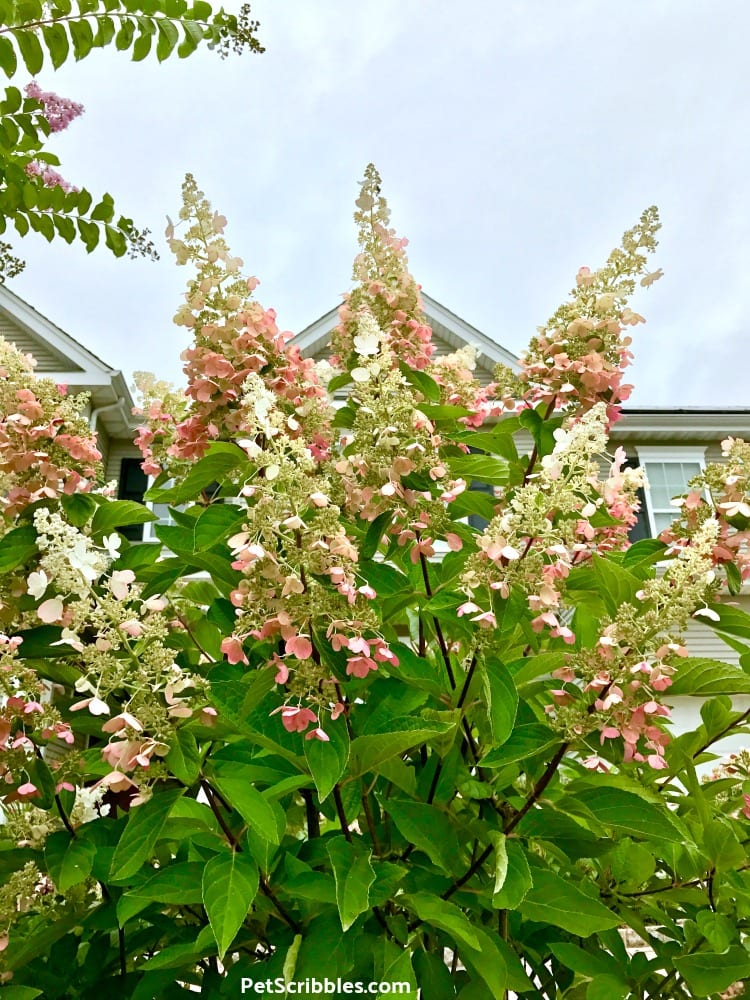
What is a Pinky Winky Hydrangea?
Pinky Winky is a flowering deciduous (not evergreen) shrub, featuring pink and white flower heads that continue to change color during their lengthy blooming season.
The full name is Hydrangea Paniculata Pinky Winky. It’s also known as a Panicle Hydrangea, which I’ll explain shortly.
Pinky Winky is one of the best — and hardiest — hydrangea varieties to survive Winter seasons without difficulty.
If you want a long season of stunning blooms that continue to change color from mid-Summer well into the Fall season — Pinky Winky hydrangea is what you want!
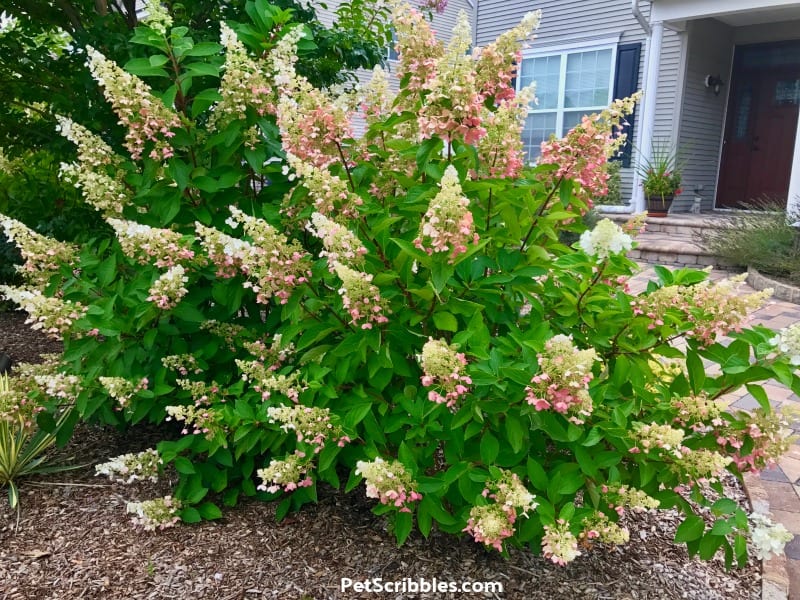
What does Pinky Winky mean?
Any time I’m asked what type of hydrangeas these are, I know that as soon as I say the funny name, there will be a follow-up question about it.
As happens with many plants, the breeder usually gives his or her new plant a unique name with some meaning — perhaps named after a beloved spouse, famous person, or a favorite color.
In the case of Pinky Winky hydrangeas, the breeder from Belgium dedicated this shrub to his son, who at the time loved the Teletubbies cartoon, especially the Tinky Winky character. Thus, Pinky Winky became the quirky name!
The breeder is Johan van Huylenbroeck, and he also developed the Bobo hydrangea, which I mentioned in my Pia Hydrangea article. Bobo is another favorite cartoon character — a blue rabbit on Belgian television!
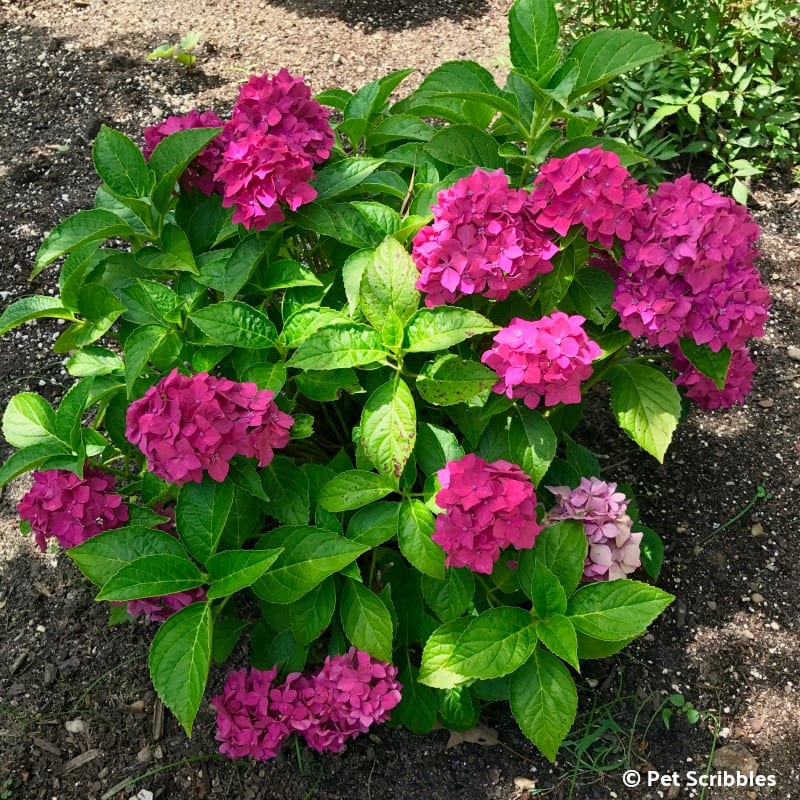
What is a Panicle Hydrangea?
A panicle has a main stem, with several smaller stems branching off from it. Each of these stems has many flowers connecting back to each branching stem.
A Pinky Winky flower head is cone-shaped and called a panicle.
Here is a panicle up close:
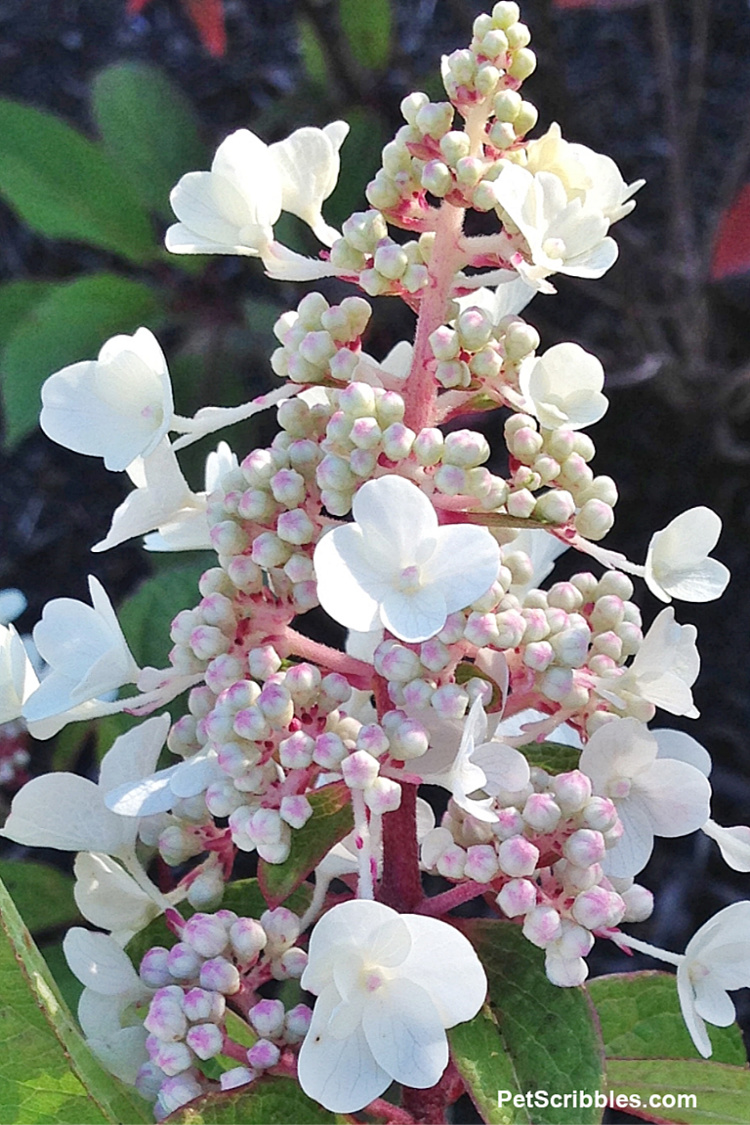
There are several off-shoots from the main flower stem, each with little flowers making up this one panicle.
The end of each panicle continues to grow longer during the growing season while producing more flowers along its length.
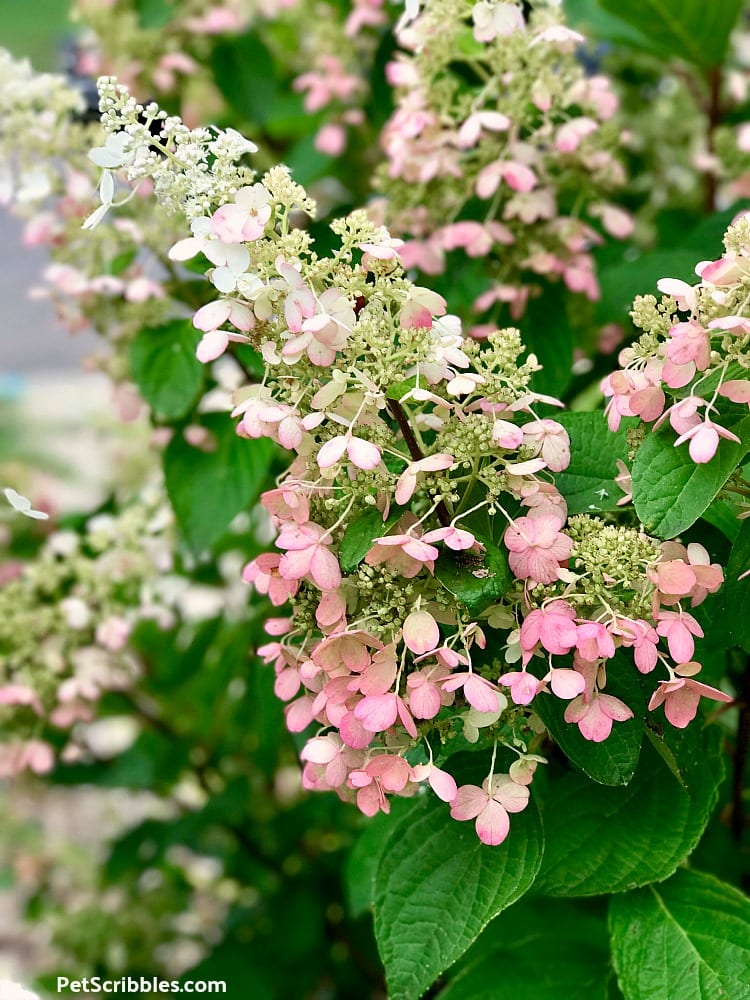
Panicle hydrangeas are considered the most hardy of all the hydrangea species.
Why You Want Pinky Winky In Your Garden
Very reliable bloomer
Unlike some varieties of hydrangeas, Pinky Winky is not fickle about blooming. We’ve had ours bloom after harsh Winters and rainy Springs, and also after a hot, early Summer drought too.
Blooms on new growth, so any die-back won’t matter
This is key, because some hydrangeas only bloom on old wood, or on both old and new wood. Pinky Winky does all of its blooming on new wood, so even if it gets frozen down to the ground, come Spring it will shoot up new growth and all will be well!
Butterflies and bees love this shrub
As we all work to make our gardens more friendly to pollinators, planting a Pinky Winky hydrangea — or two or three — will benefit your other plants and flowers. Plus, I just love the hum of the bees as they ignore me and go about enjoying the hydrangea flowers!
Here’s a brief glimpse of the bees enjoying our hydrangea blooms . . .
Spicy scent
When we first planted our Pinky Winky hydrangeas, I wasn’t aware of the wonderful scent of the flowers, until one of my neighbors mentioned how she enjoys the fragrance on her morning walks. The best way I can describe the scent is spicy with a slight hint of vanilla and honey. It’s not overwhelming. In fact, I find the smell to be calming.
Winter interest
I am a gardener who believes strongly that our gardens can provide four seasons of interest. Pinky Winky hydrangeas add to the serene look of the Winter season if you leave the dried flower heads on the stems. I do this every year.
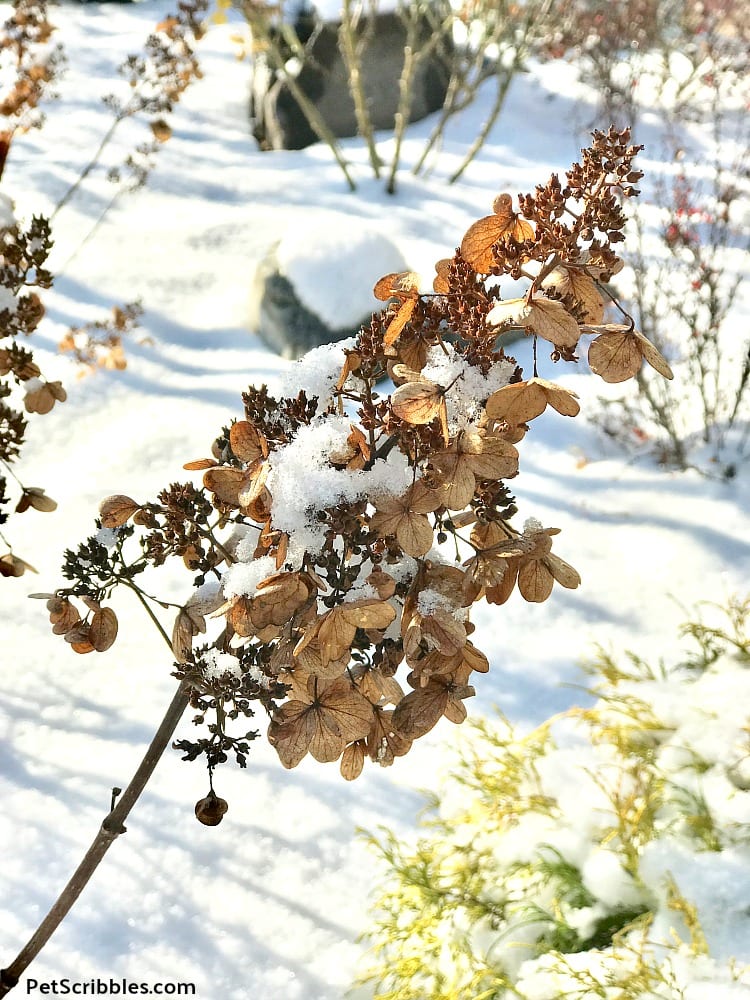
Is Pinky Winky deer resistant?
Pinky Winky hydrangeas are less interesting to deer versus bigleaf hydrangeas like the Endless Summer variety. While deer will eat just about anything if they’re hungry enough and their normal foods are lacking, it’s good to know Pinky Winky shrubs are lower on their preferred list of hydrangeas.
Pinky Winky Shrub Description
This shrub has a rounded shape, featuring red stems which show up nicely among the bright green leaves.
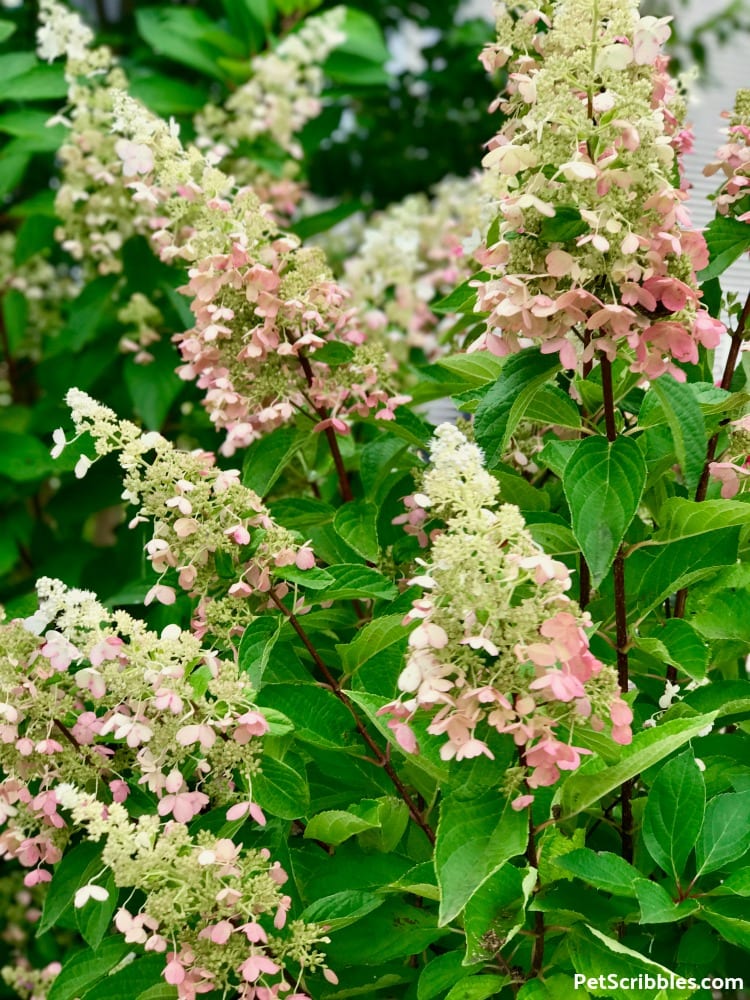
These strong stems never get floppy or weighed down by the large, cone-shaped (panicle) blossoms.
In fact, last month we had flooding rains here at the Jersey shore, and the shrubs remained upright!
Pinky Winky Shrub Size and Growth Rate
How big does Pinky Winky hydrangea get?
The mature size of a fully grown Pinky Winky hydrangea is approximately 6 to 8 feet tall and wide with a rounded shape.
However, these hydrangeas grow as large as 8 to 10 feet tall and sometimes even taller when they are super happy!
And yes, that’s even if you prune them down each Spring like I do!

How fast does Pinky Winky hydrangea grow?
The Pinky Winky hydrangea growth rate is considered fast-growing, as these shrubs grow up and out by many feet during the growing season. It’s quite impressive!
Pinky Winky Flower Shape, Size and Color
Flower shape:
Pinky Winky’s flowers are cone-shaped, as I mentioned earlier. They are considered a panicle, as each flower stem has several smaller branches containing florets which make up the larger, overall flower.
Technically, each cone-shaped panicle — which we consider a flower — is actually many flowers grouped together, all connected to the main stem of each panicle.
Pinky Winky Florets:
In the image below, notice the arrows pointing to two different types of florets.
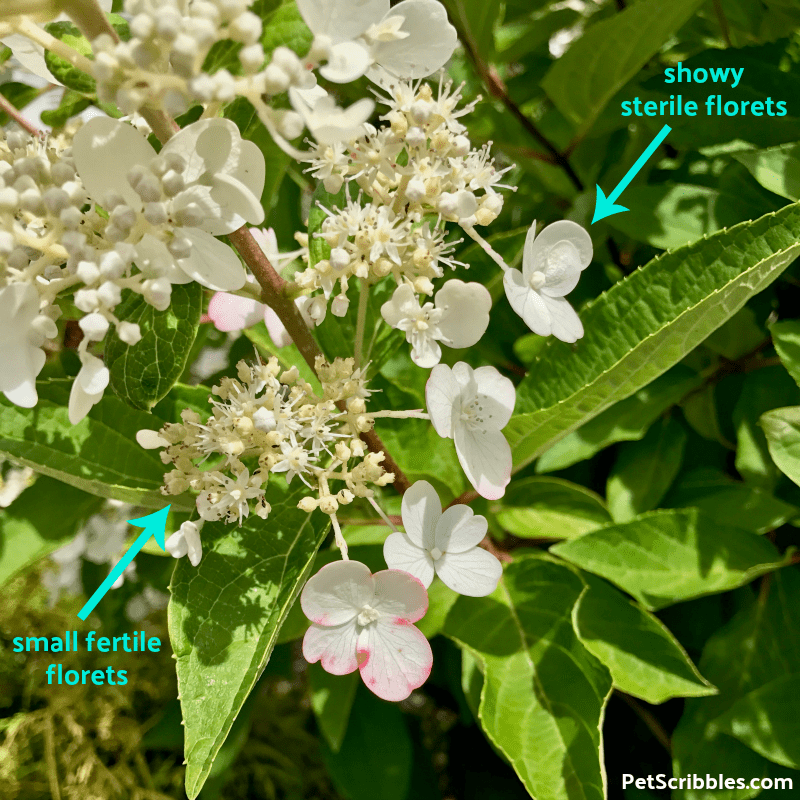
There are the small fertile florets which looks like little stars, and there are the larger showy sterile florets.
It’s the showy florets that change color over their long-blooming season from white to pink to a deep rose.
And it’s the small fertile florets that the bees love, after being drawn to the flowers by the larger sterile florets. Fun fact!
Flower size:
The large flowers grow 14 to 16 inches in length, and continue growing all season, even while they are changing colors from white, to pink and white, to fully pink, ending with a pretty deep rose color before they begin to dry.
Flower color:
Pinky Winky is best known for its pink and white two-tone blossoms, but they don’t start out that way.
Pinky Winky flowers are truly amazing because they change colors over a long season of blooming.
Flower buds develop as lime green in color, before opening to cream or white flowers.
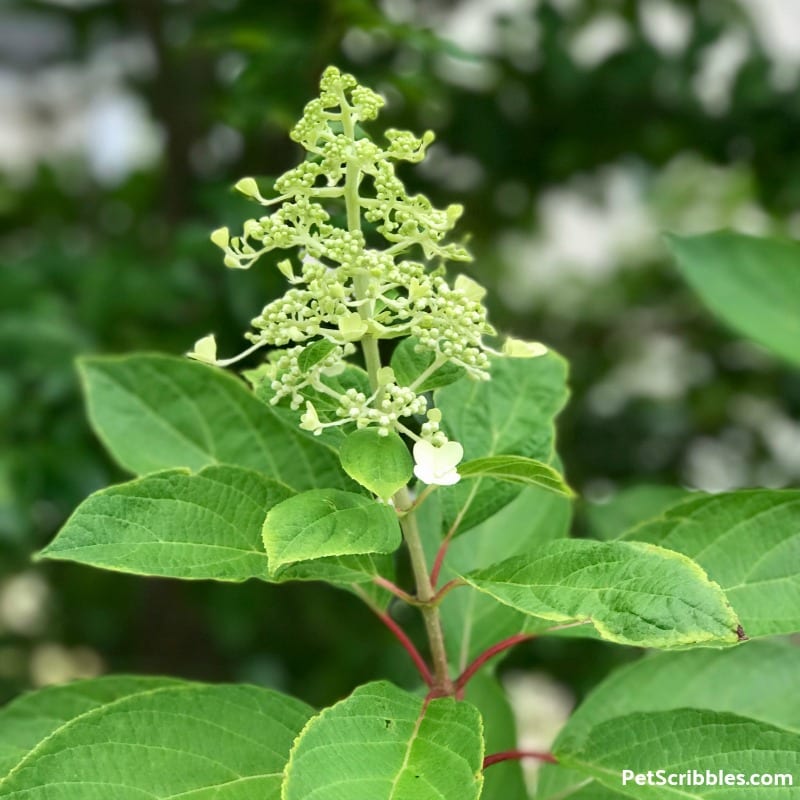
The flowers remain white for most of the Summer. For our garden in zone 7, ours begin turning pink in early August.
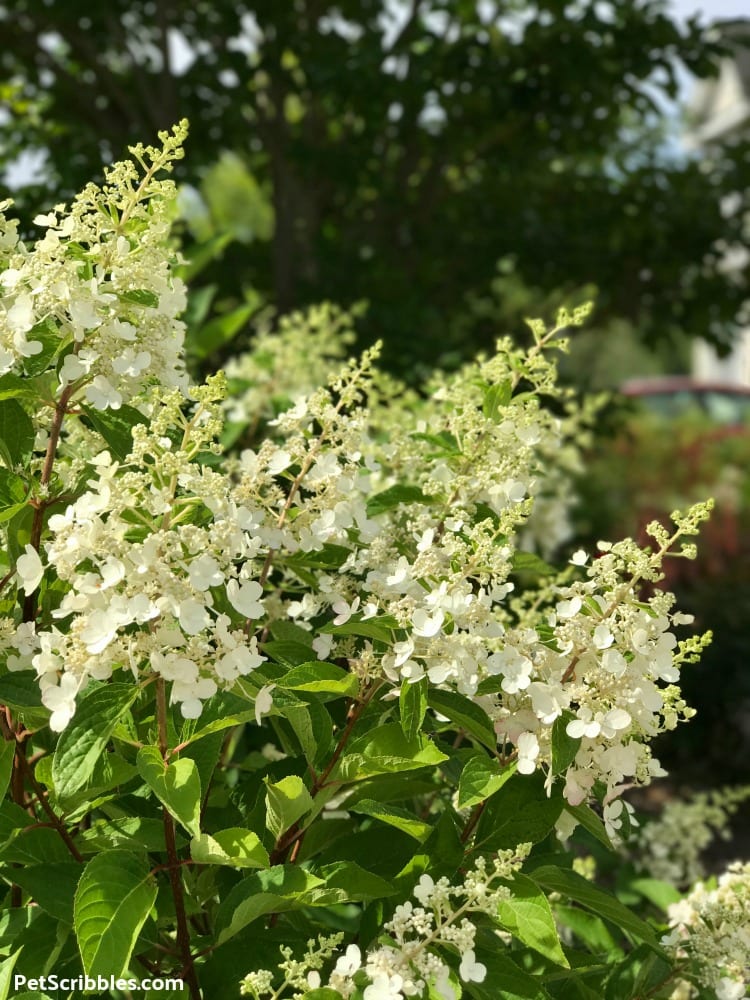
Are the flowers truly white?
Many gardeners say the flowers are white, while some say cream or ivory.
My best description is the flower color begins as a warm white, which does appear more ivory to me than white. It’s not the true white of an annual white geranium or white petunia, for example.
I think the actual shade of white is in the eye of the beholder. My opinion is a warm white shade.
Bloom time
When does Pinky Winky bloom?
The flower show begins in mid-Summer with beautiful, white cone-shaped blooms.
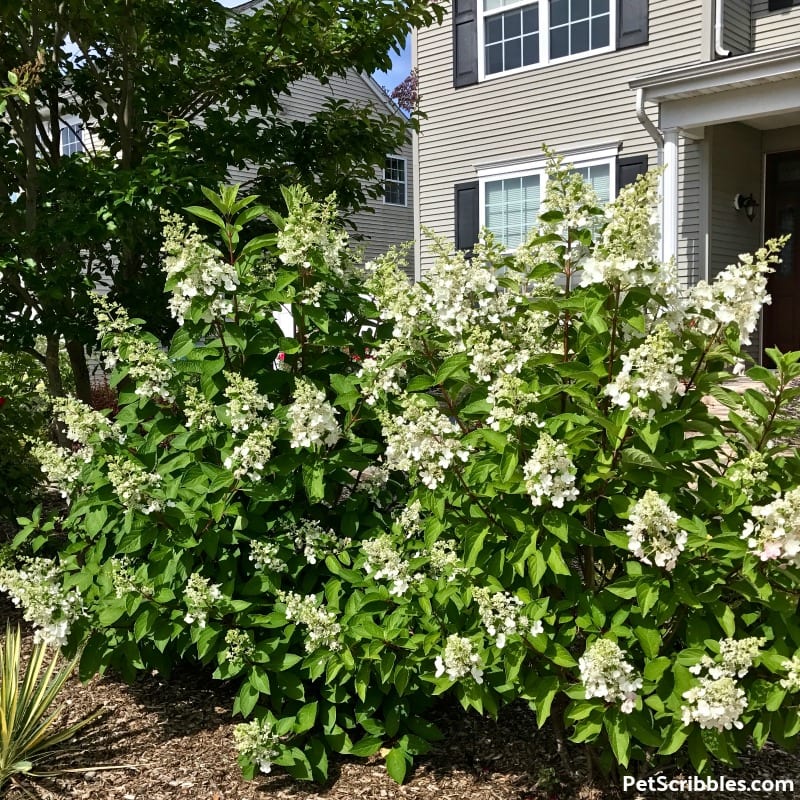
When do Pinky Winky hydrangeas turn pink?
These blooms begin to turn pink in August — here in zone 7 in southern New Jersey, starting at the base of each flower head.
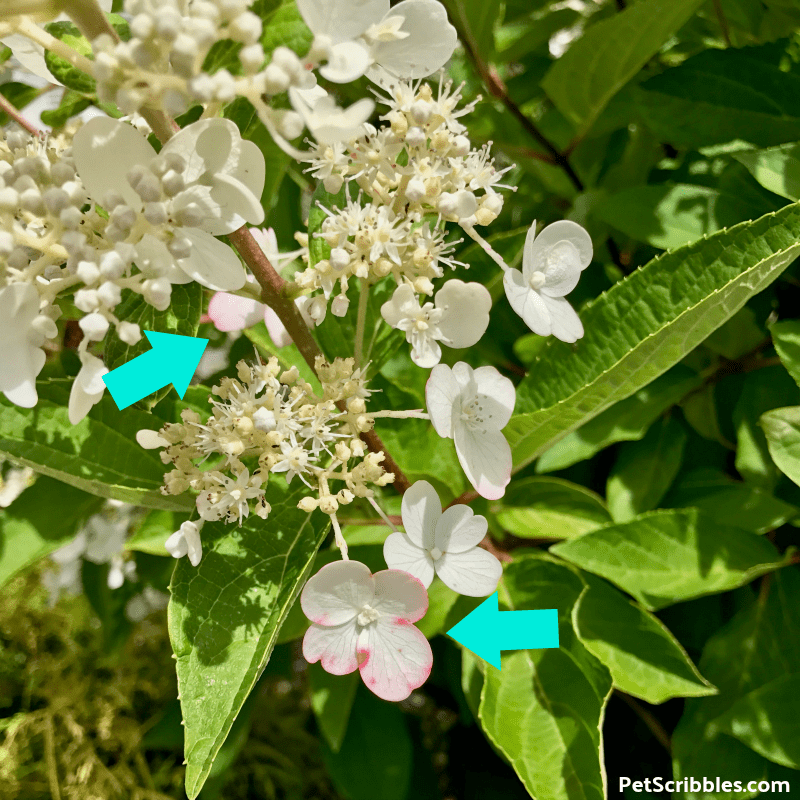
While the base of the flower head turns pink, the flower head continues to produce new white flowers at the tip. In other words, each flower head continues to grow while changing color!
You have beautiful two-toned blooms covering the shrub!
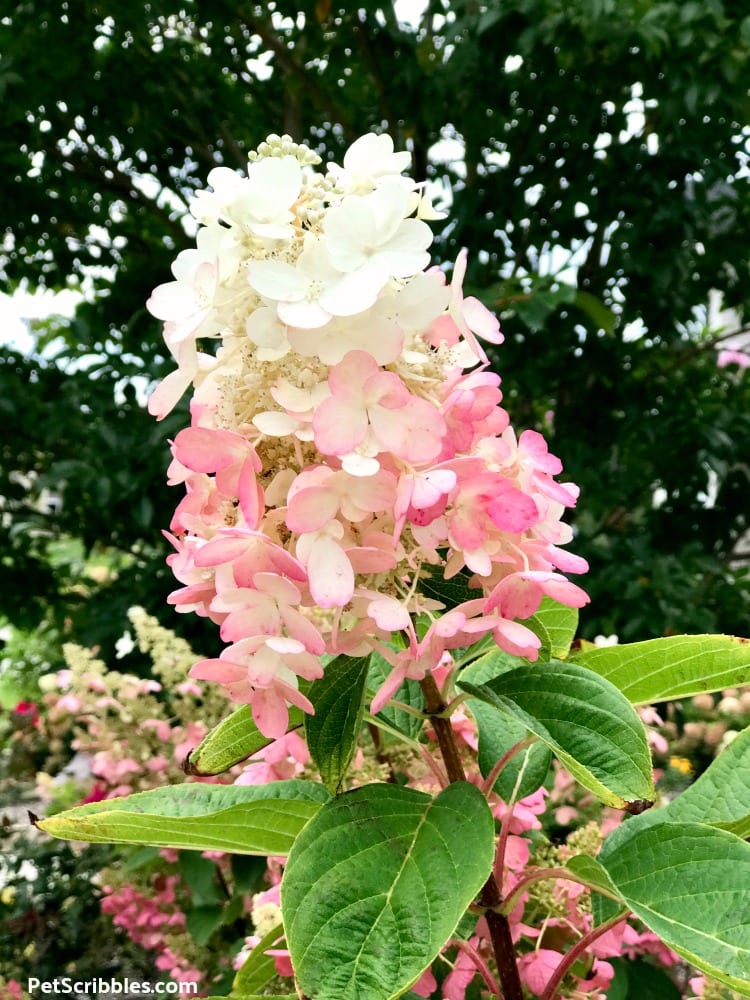
The flower show extends into the Fall season as the blooms turn pink in August and change into a stunning rose color that is perfect for Autumn.
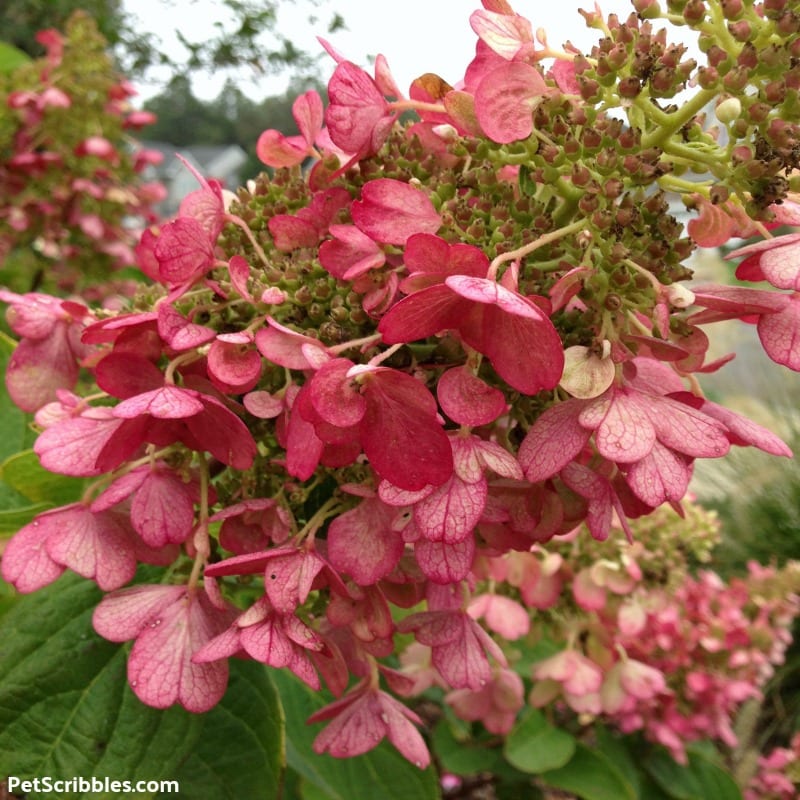
Planting Pinky Winky Hydrangeas
Best advice: Find a location in your landscape where your Pinky Winky hydrangeas can grow to their full size.
Pinky Winky hydrangeas can grow very large, and most of them do!
When to plant Pinky Winky Hydrangea
Plant Pinky Winky hydrangeas either in the Spring or in the Fall.
Spring planting: after frost
Fall planting: early enough for roots to get established

How to plant Pinky Winky Hydrangeas
As with most flowering shrubs, do not plant Pinky Winky hydrangeas too deep. Dig a planting hole only as deep as the Pinky Winky is currently planted in its container.
Dig the hole a bit wider than the sides [of the container]. Periodically check your work by simply placing the container into the planting hole to see how high or low the plant is. Adjust accordingly with more or less soil.
Place the plant into the hole and fill in the sides with more soil.
Pinky Winky Hydrangea Spacing
Most garden books and websites will tell you to space your Pinky Winky hydrangeas at least 7 to 10 feet apart.
Our own Pinky Winky hydrangeas are planted just shy of 4 feet apart. And they are doing just fine.
We have two Pinky Winky shrubs planted on each side of our Crepe Myrtle tree. Each set of shrubs slightly overlaps with a few branches every Summer, looking like one gorgeous shrub on each side of the tree instead of two.
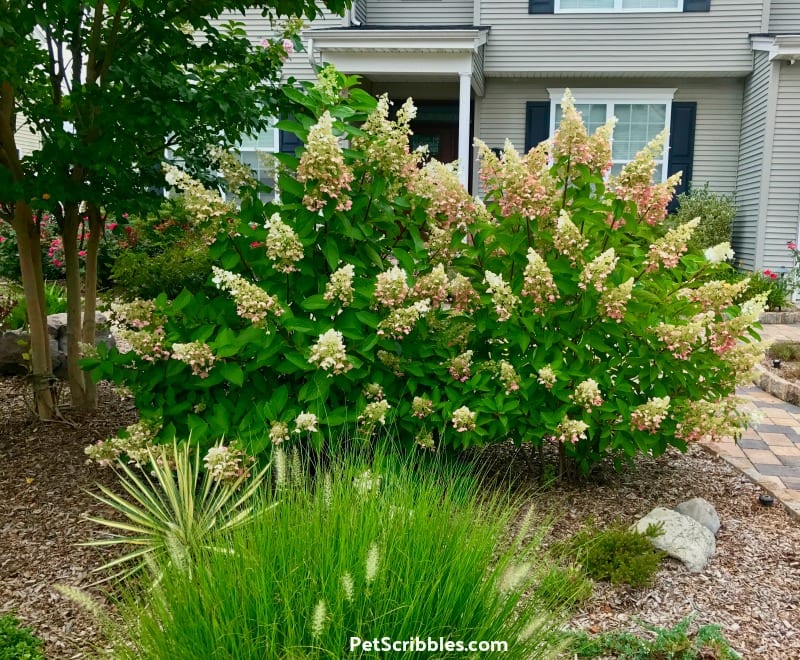
Can I transplant Pinky Winky Hydrangeas?
Yes, you can transplant your Pinky Winky hydrangeas. It is best to do so while the plant is in its dormant stage, with no leaves on the stems. This is usually in late Fall or early Spring.
Soil for Pinky Winky Hydrangeas:
Unlike several other hydrangea varieties, Pinky Winky’s flower color is not affected by the pH of the soil. In other words, the flowers will always begin as white and become two-toned with pink, eventually turning to a deeper rose pink.
Best fertilizer for Pinky Winky Hydrangeas:
The best way to feed your hydrangeas is to apply a slow-release fertilizer in early Spring, shortly after you do any pruning. My favorite organic slow-release fertilizer is Holly Tone by Espoma. *Amazon Affiliate link
Some gardeners don’t use any fertilizers on their hydrangeas and still have beautiful shrubs with lots of flowers.
Do not use high nitrogen-based fertilizers, as this can actually hinder flower production on most hydrangea varieties.
Sun Requirements:
Pinky Winky hydrangeas are happiest in either full sun or partial sun.

Watering Pinky Winky Hydrangeas:
Regular watering is required, especially when the shrubs are in their first year. Also make sure to water regularly during the heat of the Summer.
The good news is that once your Pinky Winky shrubs are established, they become more drought tolerant than some of the other varieties of hydrangeas.
Zones:
Panicle hydrangeas — such as Pinky Winky and Limelight — are more cold-hardy than other Hydrangea varieties, such as the mophead bigleaf hydrangeas.
Pinky Winky hydrangeas are hardy between USDA Zones 3 through 8, sometimes 9.
How do you know for sure if this flowering shrub can be grown in your specific zone?
If your local nursery is selling them in the Spring, then they should be good for your local climate. Always ask a nursery expert if you’re unsure.
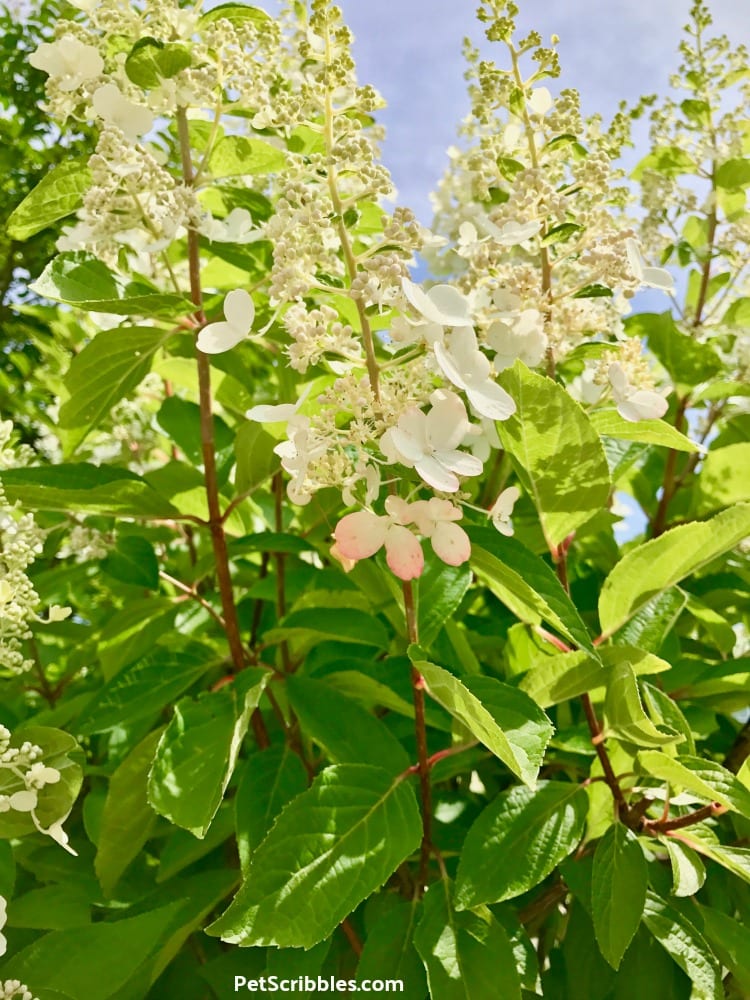
Pruning Pinky Winky Hydrangeas
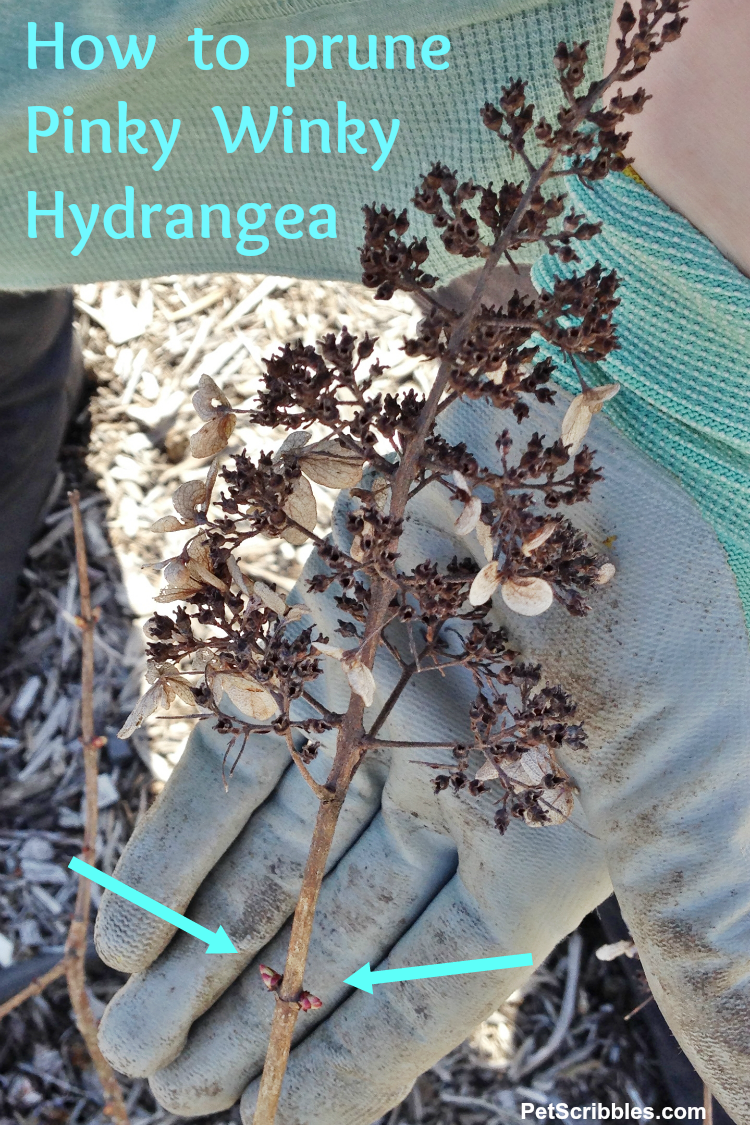
After reading so many how-to’s on the correct way to prune Pinky Winky hydrangeas — and getting discouraged by how involved some of the directions were — I came up with this easy way to prune Pinky Winky hydrangeas — if you need to prune them at all.
It can be super-intimidating when researching that new shrub or plant you purchased. Am I right?
You planted it in the ground last Spring, and now it’s time to kick-start your garden again. Knowing what to prune — and when — can get overwhelming.
Dumb it down, Einstein!
So I’m trying to dumb it down for my own benefit, and hopefully help you too!
Our Pinky Winky hydrangeas were planted a few years ago when we had our front landscaping completely redone. They are from Proven Winners.
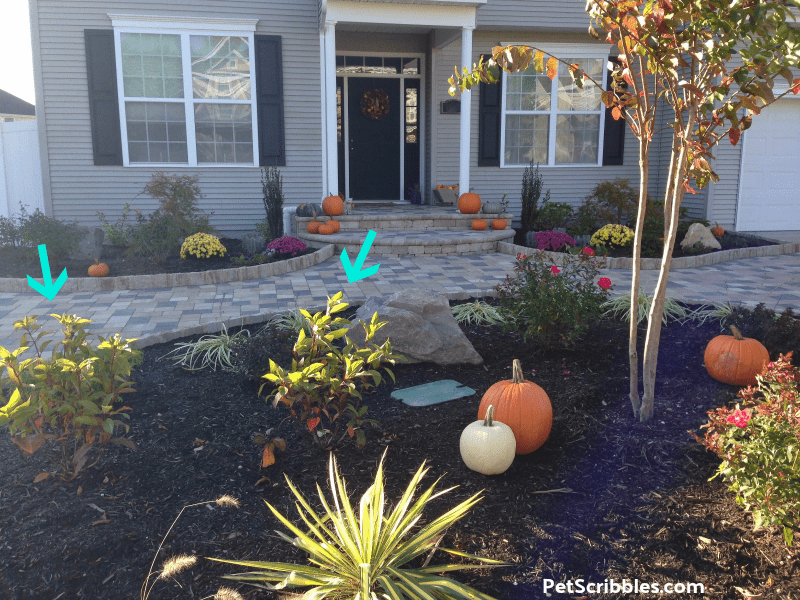
The arrows show the Pinky Winky shrubs, just one month after planting. There are two more planted on the other side of this large bed as well.
When to prune Pinky Winky Hydrangeas?
The best time to prune your Pinky Winky hydrangeas is in the early Spring.
Pinky Winky hydrangeas bloom on new wood every year, so if you are cutting off brown twigs that have grown too high for your taste, don’t worry that you’re removing potential blooms.
How to prune Pinky Winky Hydrangeas the easy way!
Here we go — instructions in a nutshell, so you can read this and get outside to prune your own Pinky Winky hydrangeas!
Here’s what our Pinky Winky hydrangeas looked like in early Spring this year.
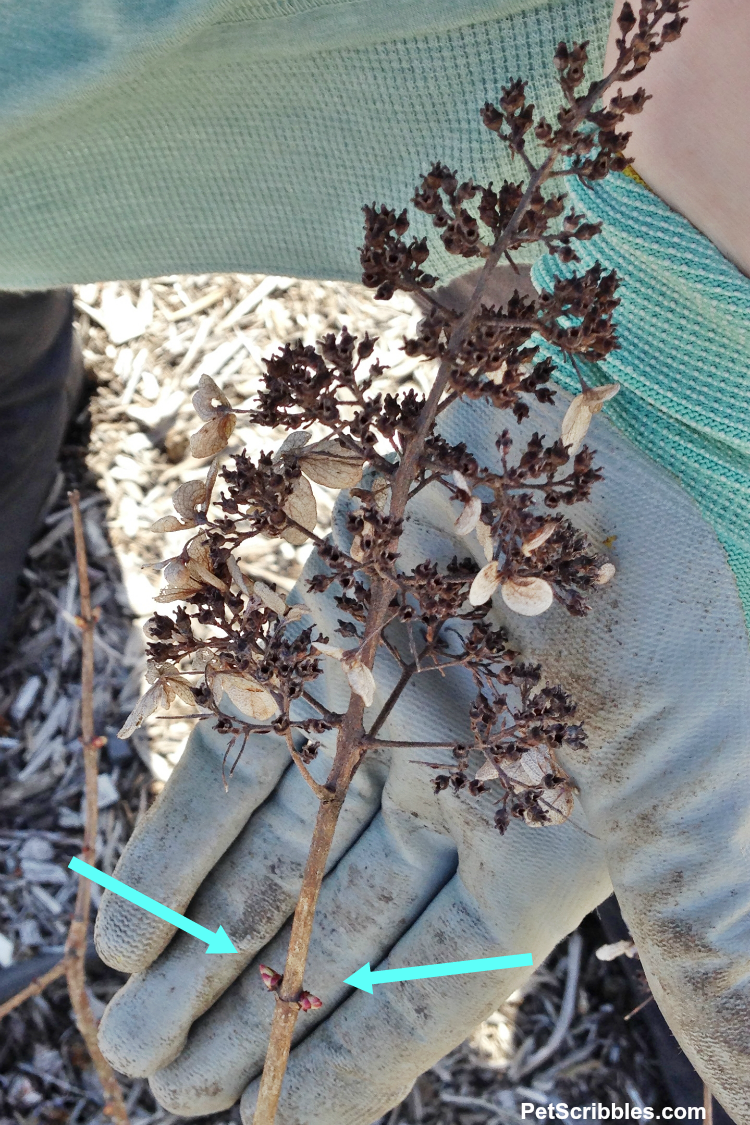
(I almost want to ask you to pardon my dirty garden gloves. Almost. But I’m keeping it real here, and these are usually what my gloves end up looking like after awhile!)
I like to leave the dried flower heads on our hydrangeas (all types) for Winter interest.
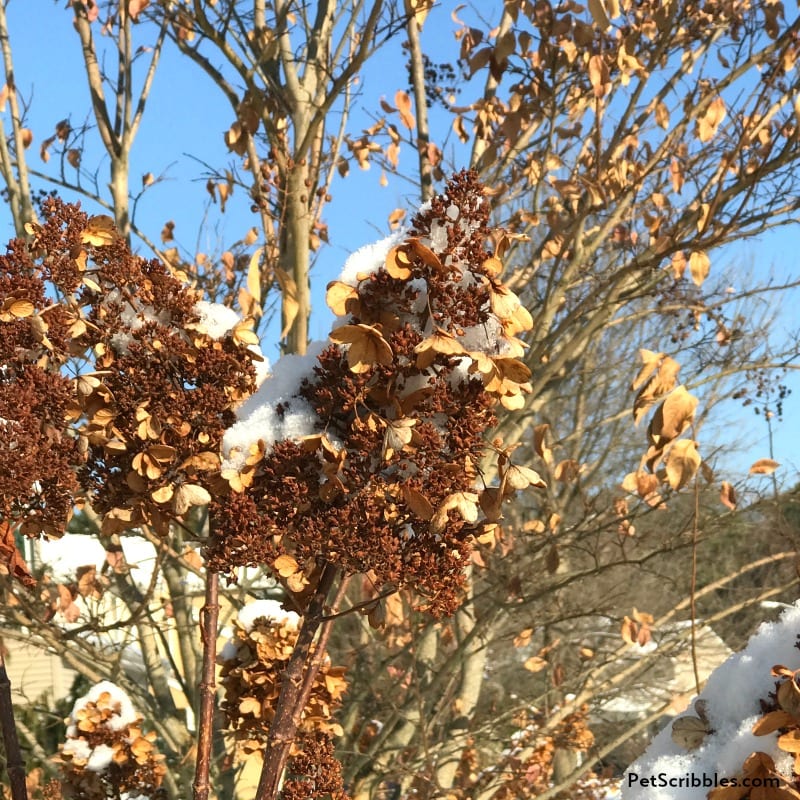
Sometimes they end up being blown away by fierce winds, but mostly they stay on the plants and I like the look.
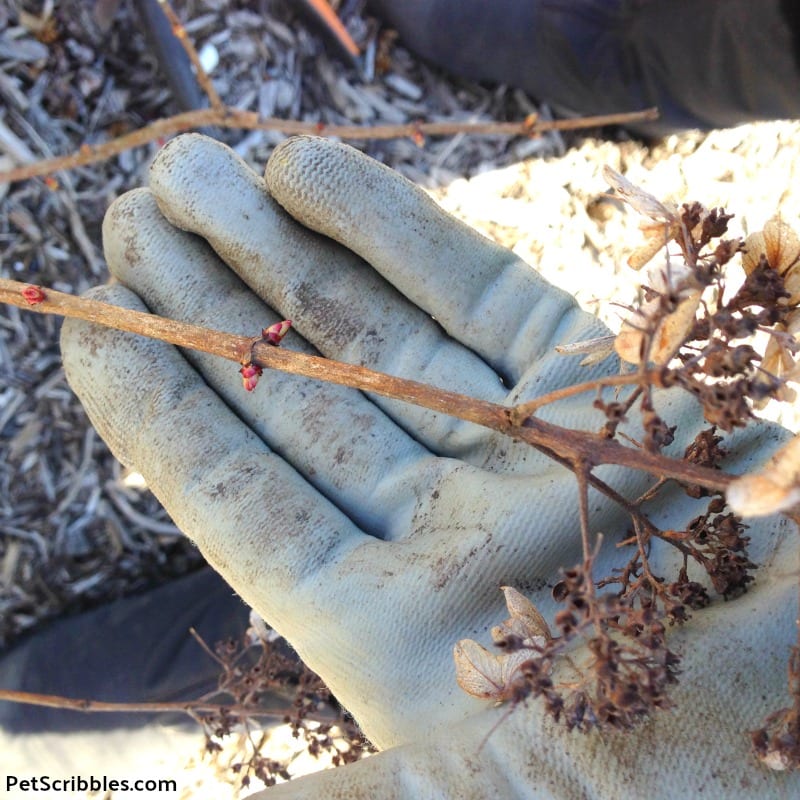
Step One: Start at the end of a particular branch — and in my case it will be at the very tip of the flowers.
Step Two: Now follow the branch away from the tip until you see the first set of buds forming.
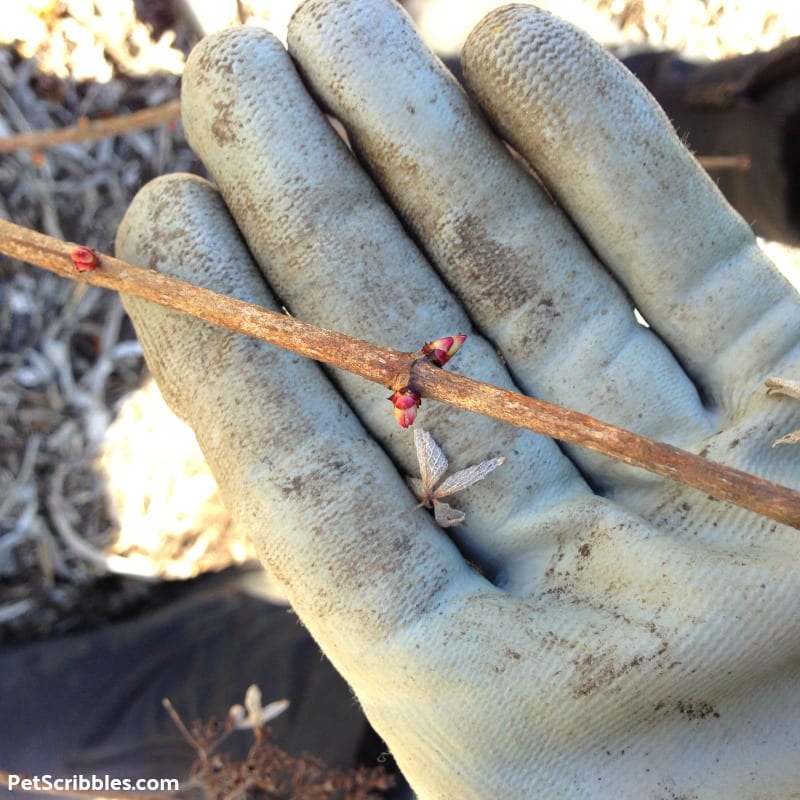
Your eyes won’t have to travel down the branch very far.
Step Three: Take your hand pruners and simply make a cut just above those buds.
That’s all you need to do!

Here’s what one of the Pinky Winky hydrangeas looks like just one month after being pruned.
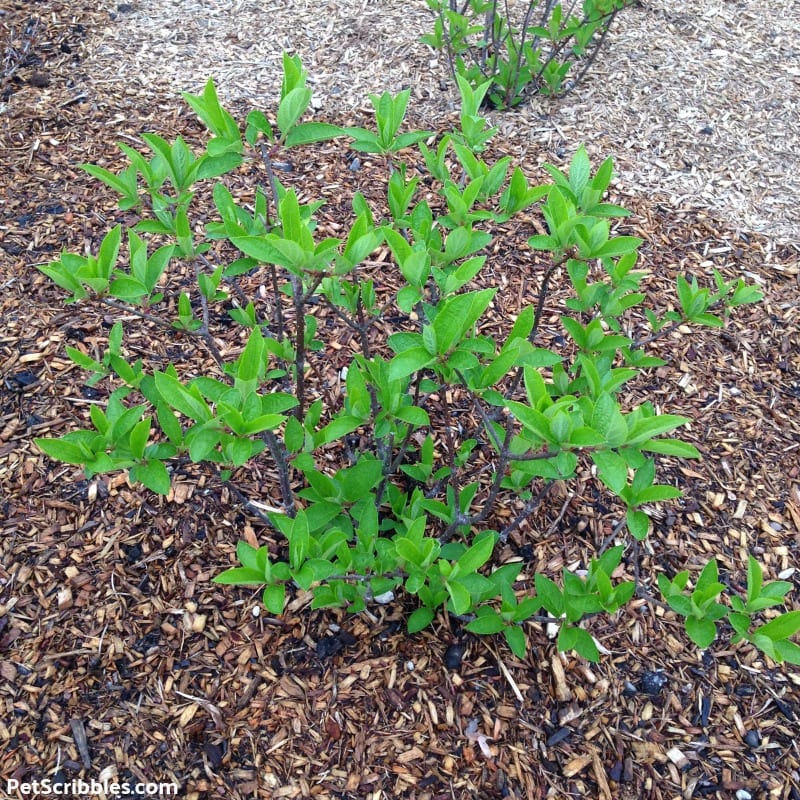
You can’t even see where I made any of the cuts, so all is well in my world!
Didn’t I mention possibly no pruning is needed with Pinky Winky Hydrangeas?
Why yes I did.
While you will come across many a garden book, online article or blog post on the internet about the precise way to prune Pinky Winky hydrangeas — such as pruning back certain branches in order to get larger blooms — I simply don’t have time for that.
You don’t either. (And if you do — kudos to you, because I just don’t have that amount of patience!)
If you don’t want to prune your Pinky Winky hydrangeas, you honestly don’t have to.
Many gardeners just prune a stray branch here or there to keep the shrub tidy. Or perhaps they prune any branches that are crossing (and touching), as that could cause the branches to begin rubbing against each other and some kind of bad, evil fungus could set in.
And there are gardeners like me who will prune just like I showed you above.
The point? It’s up to you!
Try whichever way works best for you and then see how your hydrangeas do.
That’s really all we can hope for, right?
We try our best at taking care of our garden plants and shrubs, and over time we learn what works and what doesn’t quite work.
Pinky Winky Hydrangea Images
Personally, I think of Pinky Winky hydrangea as a four-season shrub.
First, there’s bright green new growth in the Spring, followed by lime-green buds turning into white blooms. As the Summer continues, you get the pretty two-toned pink and white flower heads, which then continue to transform into a gorgeous rose color for the Fall season. Finally, the dried flowers look so pretty in the Winter landscape, especially in the snow.
New Growth in Spring


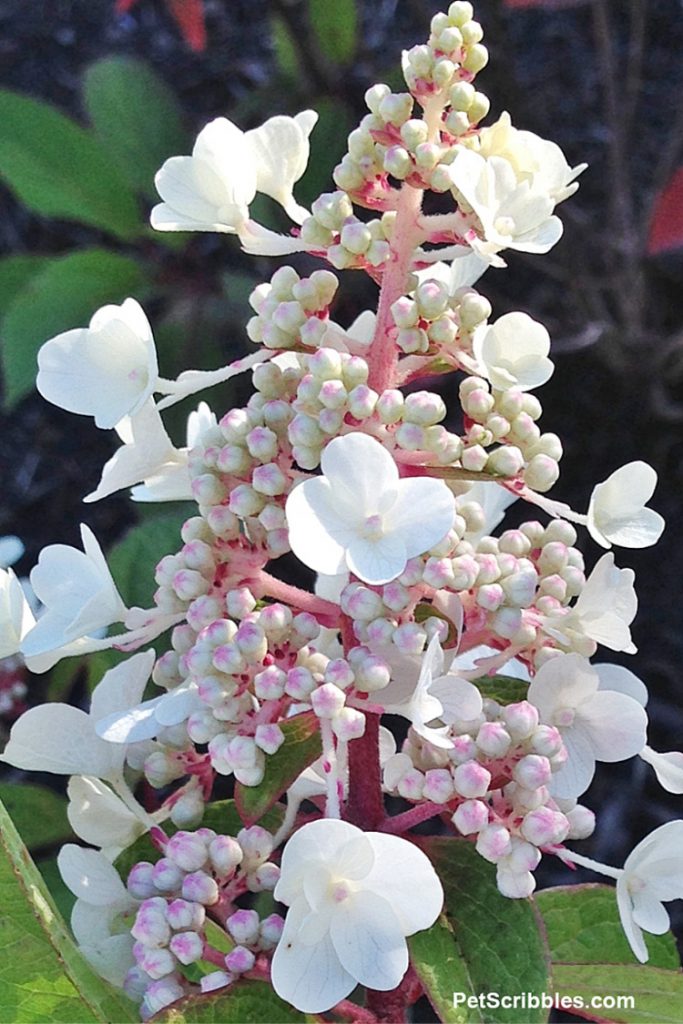
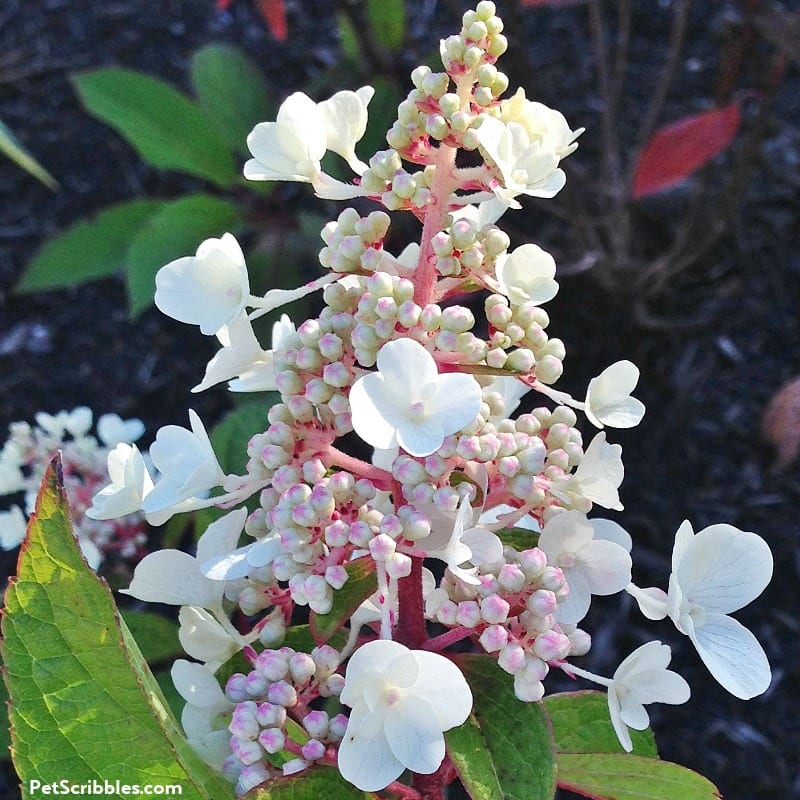
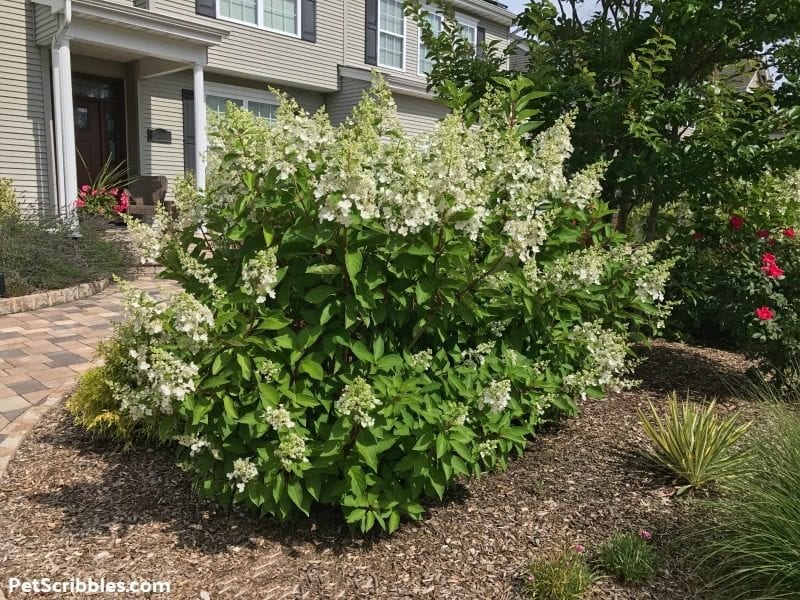
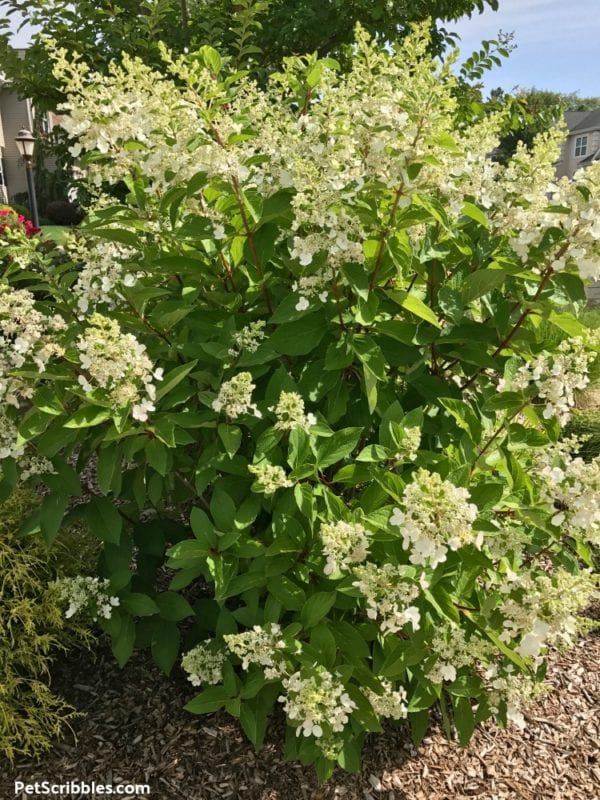
Pinky Winky in Summer
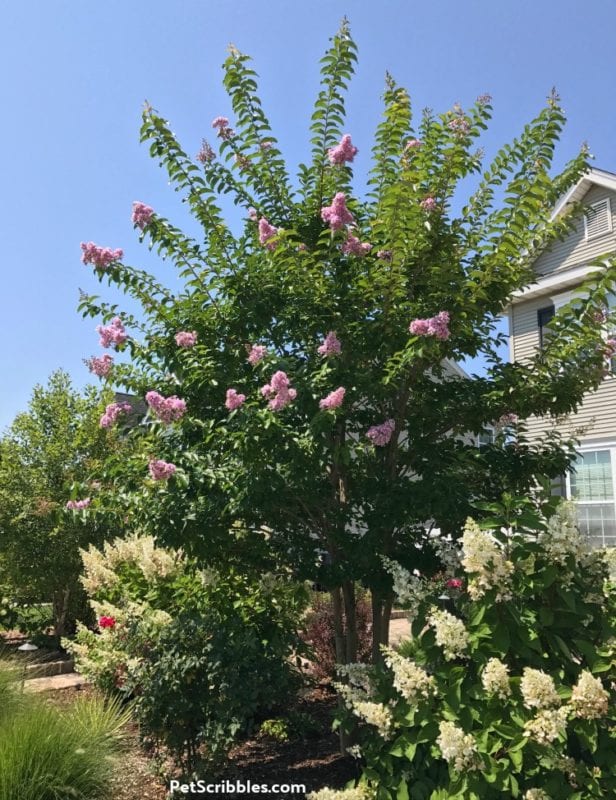

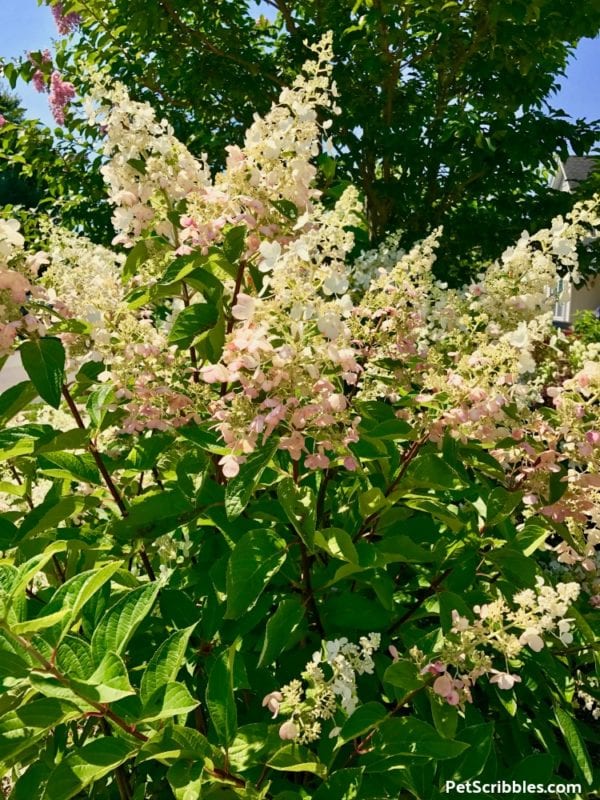
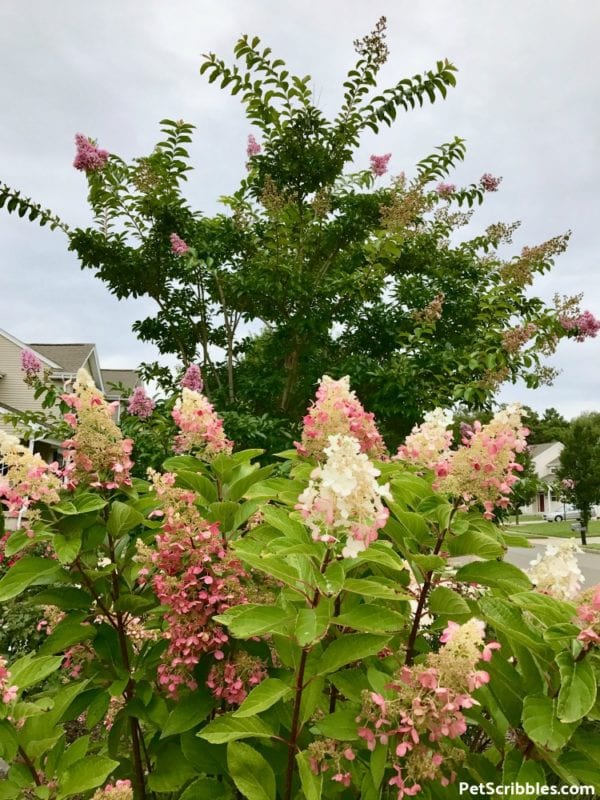
Fall Color and Texture
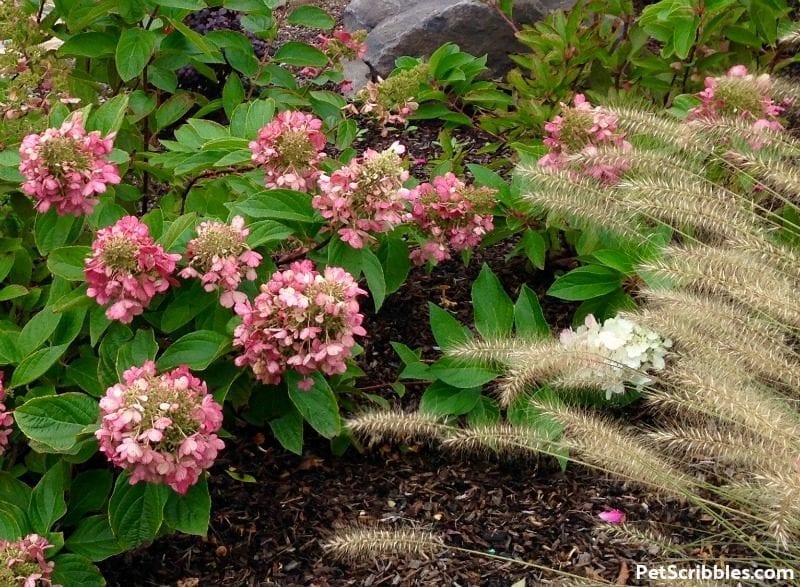
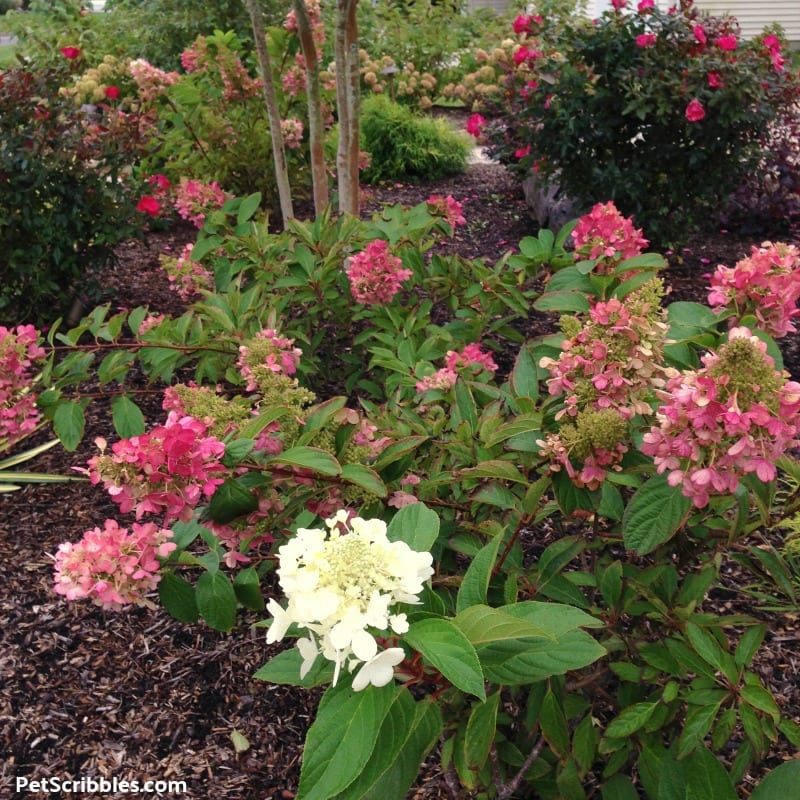
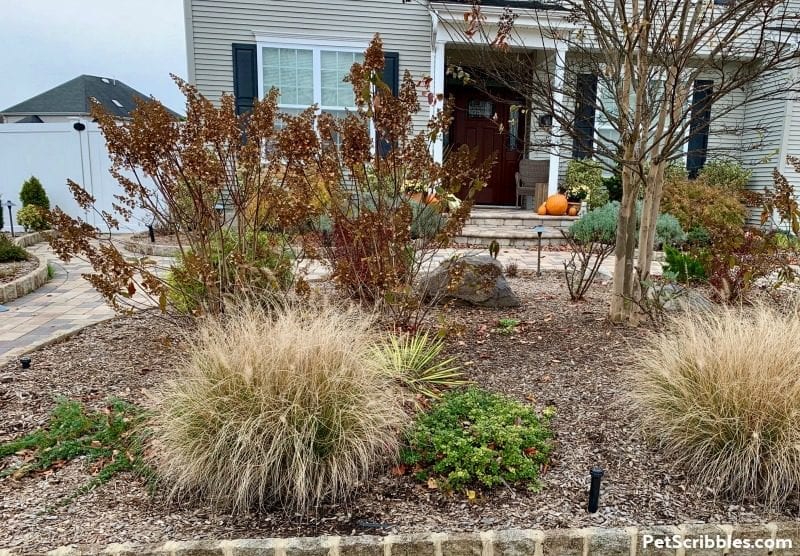
Winter Interest
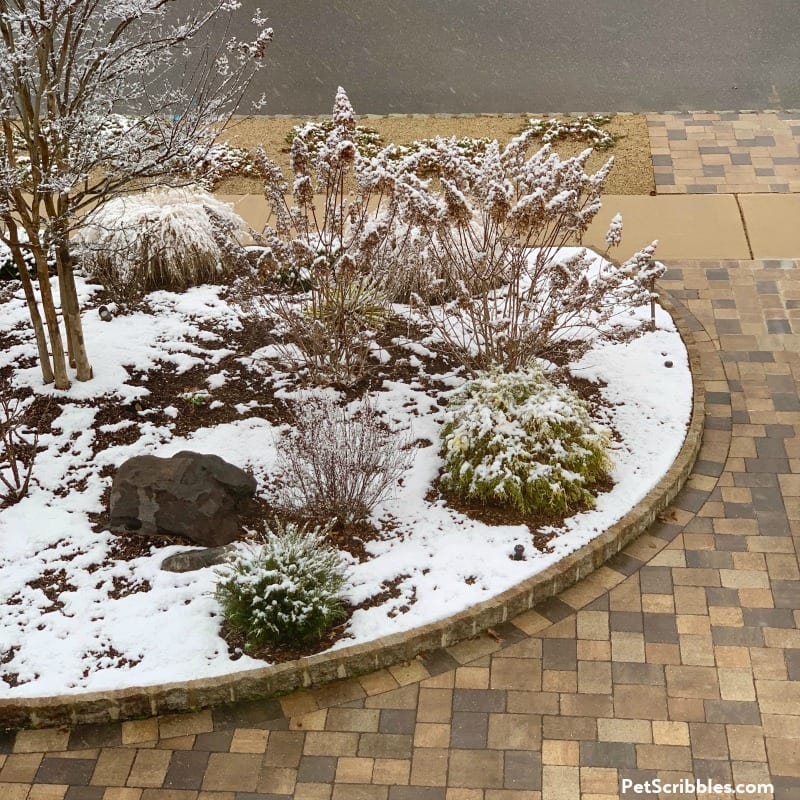
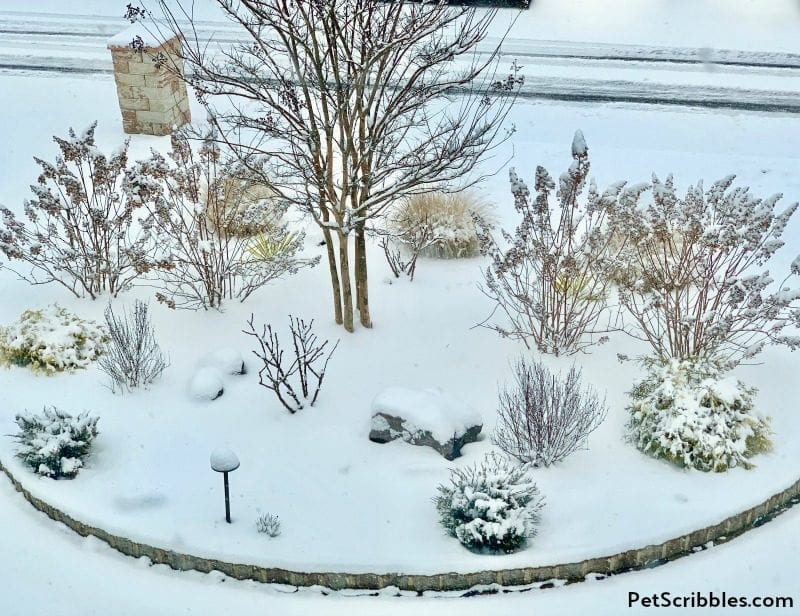
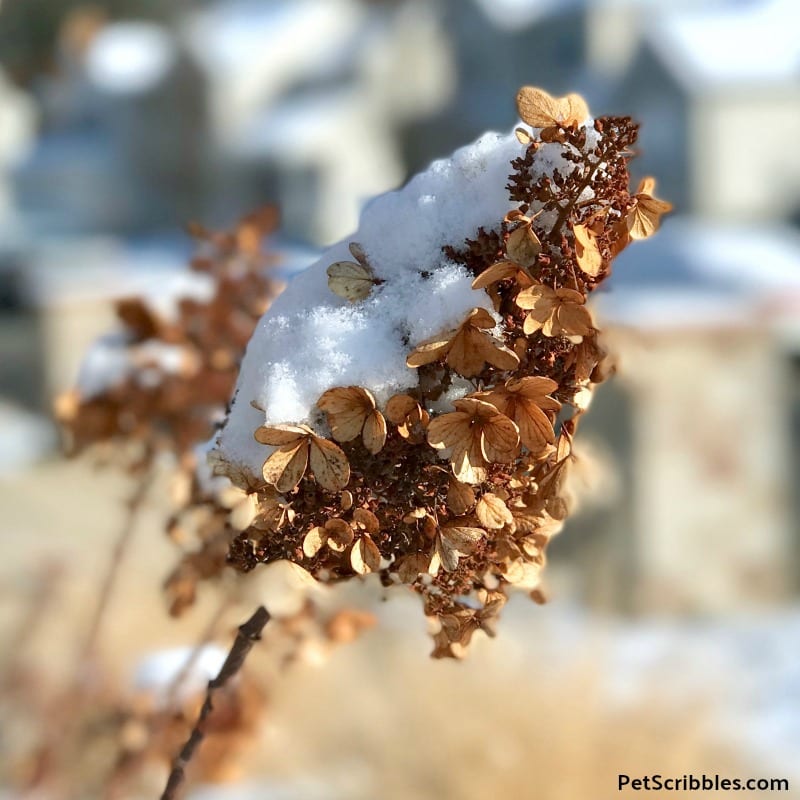
Happy gardening!

Are your pinky winkys in full sun? I planted mine a full sun spot and it’s not doing so well! The leaves are really drooping!
Hi Miranda — yes mine are planted in full sun. For the first year, you will want to water them a lot until they get established. It can be frustrating at times to see those droopy leaves, but until the root system gets going underground, you’ll see droopy leaves from time to time. When you water, make sure to water “deeply” to get the water to soak way down into the ground underneath any mulch or surface soil. It’s better to water deeply a few times a week versus water lightly every day. If the water doesn’t get down deeply, the roots will remain more towards the surface (where the water is). Pinky Winky is happiest in full sun or partial sun, so it can definitely handle the sun….in the beginning it just needs help from us with more water than it will need in a couple of years when you’ll be so happy it is thriving. Fingers crossed! Let me know how it goes, ok?
Hello,
Thanks for your information. I have no experience for planting. I just bought this flower. But I want to plant it in a pot, because I’m not allowed to plant anything in the garden soil, just only grass (rent house). Is it possible? And how many times do I need to water the flowers per day? Thanks so much.
Thanks for your question Mina. I think you can plant your Pinky Winky into a container. Just make sure the container is large enough to hold the plant, as it will get fairly large. Depending on what type of container you use, just keep in mind that containers can dry out more quickly than soil in the ground, so I’d suggest watering every day, especially this first season of planting. Add some mulch or decorative pebbles or rocks on top to help keep the moisture in the pot. In the Fall, you can let the plant go dormant naturally.Follow my suggestions for what to do in the Spring just as if your Pinky Winky was in the ground. Let me know how it goes!
I just planted my pinky winky’s last year. They are doing good this year. I understand the flowers grow off new wood, so what happens when they reach their higth and wilth, there’s no new wood. Does that mean, you won’t get flowers at that time? Please help me understand what to do. I want a lot of flowers every year. Thank you!!
Hi Catherine, I’m happy to hear your Pinky Winkys are doing well! Pinky Winky hydrangeas bloom on new wood every year, so if you are cutting off brown twigs that have grown too high for your taste, don’t worry that you’re removing potential blooms. As well, if you don’t want to prune them, you don’t have to. New stems will grow out of the old stems, plus new stems will shoot up directly from the base of the plant from the ground. I love the height and width of our Pinky Winky Hydrangeas, but I’ll still cut them down in very early Spring, and those plants rebound and grow back up nice and tall. You’re right that we always want lots of those great Pinky Winky flowers! If and when you are considering pruning your Pinky Winkys, refer back to my section above on Pruning. Thanks for your question!
Hi Laura. What a great article!! Very informative yet simple. Thanks for all of the tips! I just bought my first Pinky Winky and I am so excited to plant it and watch it grow. I had never heard of the Pinky Winky before and and just happened upon one at a neighboring ladies discounted plant sale while looking for other plants. I fell in love with the look and smell of the Pinky Winky immediately. I’m glad I read your article ahead of planting because I would have put it in an area that would have been too small for the potential growth of my Pinky Winky. From one gardener to another, thanks again!!
Thanks for your comment Juanita — you made my day when I read this and I meant to reply sooner! Keep me posted how your Pinky Winky does. The scent IS lovely, and as your plant gets established over the first couple of years, you will enjoy the scent more and more! This is one of my favorite plants, and I hope it becomes one of your favorites too! Thanks again!
Hi! Just curious what kind of tree do you have growing in between your 2 hydrangea bushes? (the tall tree with pink flowers). Beautiful garden and very helpful tips for a new gardener here. Thanks!
Hi Laura — Great name, by the way! :). The tree growing between our two Pinky Winky Hydrangeas is a Muskogee Crepe Myrtle. It has pretty lavender-colored flowers on it late Summer into the Fall. So glad you’re finding my tips helpful! I’m happy to answer any questions!
I have 13 pinky winkies across my back wall. This is their first year and we had a terrible time with Japanese Beetles. We were invaded and I mean invaded. I could count upward of 1000 dead ones. We used Seven and were having to use it daily and finally had True Green come in and spray them. Does anyone have a better solution going forward to next year? We were advised not to use the traps as they encourage them to come from neighboring yards.
Hi Deborah, I’m very sorry to read about the infestation of Japanese Beetles you had this year — especially after planting 13 Pinky Winkies. My best suggestion is to use a product for grub control. Grubs turn into Japanese Beetles, so if you can get them killed off while in the ground, you’ll have a much better time next year. What also needs to happen — and this is the tricky part — is to mention to your neighbors to work on grub control too. Sometimes this can be tricky, I get it. Maybe start by asking them if they’ve had a Japanese Beetle problem this year. You could mention how you’ve been told you can treat it, but it will help everyone if your neighbors do it too. I imagine that the many Japanese Beetles you saw also were feasting on the neighbors plants? There are many products on the market that you can add to your soil or the ground/lawn whatever you have. Some are sprays, some are powders, some are granules. Now — in September — is a great time to apply this product. Look for a grub “killer” not just a grub “control” or “preventer” since you need to kill those grubs. There are also organic products as well. Follow package directions, as some products you can apply now AND in the Spring, so hopefully this will help you next year. Your poor Pinky Winkies! I sure hope they — and you — have a better season next year! Keep me posted!
My pinky pinky hydrangeas are very large. Can I prune them back to about two feet from the ground and when?
Hi Elfie — The best time to prune your Pinky Winky hydrangeas is in the early Spring. And yes, you can definitely prune them to just two feet high from the ground, as these gorgeous shrubs develop their flowers on new growth each season. See my section on “Pruning” in the above article for more details and to see pictures of how I prune my own hydrangeas. (You’ll see I also prune them way down each Spring.)
Hi Laura, thanks for all the helpful information! I planted a Pinky Winky late summer/early fall and live in the Upper Peninsula of Michigan on Lake Superior. Our winters are very snowy and cold, do I need to do anything special to protect this plant from the extreme weather elements? Thank you for your help!
Just make sure that you’ve got a layer of mulch on top of the soil around the Pinky Winky as this will help to protect the roots. These shrubs are VERY tough and hardy, which makes them so wonderful!
I live in northern Indiana. I have a 5 ft. tall Hydrangea paniculata Pinky Winky that I want to plant by a deck to be built this spring. Should I temporarily plant it in my garden or just leave it in the pot?
Combine both of your ideas: temporarily plant it in your garden WITH the Pinky Winky still inside its pot. Then, in early Spring take it out and plant it in its permanent home. That’s what I usually do with plants we haven’t yet had time to plant and the season gets away from us. (I just did that with three small grasses, in fact.) If you just leave it in the pot “outside” of the ground, no doubt it will dry out and not survive the Winter season. You will adore this plant!
Hi , this was really helpful! I get mixed up with the old wood and new wood terms. Do you prune Fire and Ice Hydrangea the same way?
Thanks
Hi Gail — great question! Yes, prune Fire and Ice Hydrangea the exact same way as I described for Pinky Winky. Fire and Ice also blooms on new wood, as it is in the same class of hydrangeas: panicle hydrangeas. I bet your Fire and Ice is stunning throughout the Summer into Fall — they are beautiful with their changing colors!
Hi! I just ordered a pinky winky tree that I plan to plant In morning sun only. Will it do ok? Do you know how big the trees get? I can only find information on the size of the shrubs.
Thank you for your wealth of information!
Hi Katie — Tree forms of Pinky Winky grow approximately 10 to 12 feet tall by 8 to 10 feed wide. And they do best in full sun to partial sun, so you should be fine with your placement. Not knowing what your climate zone is, in hot climates these Pinky Winky trees (and shrubs for that matter) do well with some shade each day. I hope this helps! Let me know how it grows!
Very interesting and informative article! I planted a Pink Winky just last year (late May). It is super slow to leaf out and get growing. I’d say it’s barely 12″ out of the ground with new growth. Is it too late to put down HollyTone? I have some and didn’t do it in early spring. Also – how many years will it take it to get even half it’s size? I feel I am impatient! 🙂
Thanks Cathy, and yes you’re right: Pinky Winky can seem very slow to get growing. However, once it starts you’ll be relieved and happy! It’s never too late to put down HollyTone, as it is a slow-release fertilizer and will just start helping the plants and soil immediately. Once you put it down, water it into the soil unless you’re expecting rain then you can let nature do the watering for you. Did you cut it down last year to the ground? New growth appears on the stems from last year as well as new growth from out of the ground. Keeping the stems — if you can — and not pruning them back will help the plant keep a better height you will like. Never fear, however, because when Pinky Winky are happy they will grow nicely for you. Since yours has now had a full year to get its roots established, I think you will have a nice blooming season. Not sure where you live, but plants and shrubs also have a different “natural” bloom time and growing time that differs from what we purchase at a nursery. Nurseries often work on getting their plants to bloom timed to when these plants will be sold, so that customers can “see” what the blooms will look like. I had to learn that when I felt like my plants were taking a bit longer than I had thought they would. Keep me posted please!
Hi Laura! Thank you for the reply. Well, shoot, I did trim last years stalks down as I thought I read that it blooms on new wood. I will remember that next year! Good points about blooming naturally in its time. I am in central Iowa, zone 5B. I will be sure to get HollyTone down soon (today would have been great, we had a nice soaking rain!) I cleaned out a whole area of Gooseneck Loostrife (bully) to accomodate the Pinky Winky and 3 Fine Line Buckthorns behind it a ways. So, this looks really bare compared to my full hosta beds beside it! I will keep you posted! Thank you!
Oooh that’s good to know that Gooseneck Loosestrife is a bully because I’ve been eyeing that plant to add to my garden. Your garden sounds wonderful, and I think your Pinky Winky will produce a nice array of new stems and blooms this year, but the shrub might be shorter than you’d want. While the blooms happen on new growth, that new growth can shoot out of the “old” stems” if that makes sense. So think of the old stems as a platform of sorts to raise the blooms higher. Looking forward to hearing how it looks in another month or so!
Hi, Laura, Love your post. I am new for Hydrangea, Just bought three Limelight and one Vanilla Stawberry hydrangeas this year and they are doing very well. I am thinking to buy more hydrangeas for a privacy hedge between near door neighbor. Which kind do you recommend? Thanks!
Hi May, I’m thrilled you purchased Limelights and a Vanilla Strawberry — you will adore them for years and years to come! I’m not sure if I would plant hydrangeas of any type to use as a privacy hedge, only because during a good portion of every year they won’t be blocking anything. If you look at some of my images in this post as well as in my “Little Lime Hydrangeas” post on here, you will see photos of the hydrangeas in Winter and early Spring. In Winter, the twigs are very see-through, so no privacy there. And in the Spring, it takes quite some time until the twigs begin to leaf out, fill in and then begin to grow taller to their maximum heights reached every Summer.
If, however, you’re looking for privacy from hydrangeas for the Summer and into the Fall season to perhaps block an outdoor area to enjoy, then I’d suggest the panicle hydrangeas, of which both Vanilla Strawberry and Limelight belong. Both Vanilla Strawberry and Limelights grow between 6 feet and 8 feet tall, which would provide a nice amount of privacy during their peak blooming season, especially if you plant several to use as a hedge. And speaking from experience, our Pinky Winky Hydrangeas block everything while they are blooming in the Summer! Firelight is another one, growing to 6 feet tall, but the bottoms can be a bit more open. Zinfin Doll is another one that grows up to 8 feet, but has a more leggy and open bottom part of the plant. The main thing you will love is that these plants are each so carefree, not requiring the “babying” that I feel we have to do with the mophead hydrangeas which require so much watering and talking to. 🙂 I hope this helps!
Hi Laura,
Great informative article. Thank you! I just planted two Pinky Winkies, I live a Chicagoland area. I see that I should of waited until fall to plant them(because you suggested spring or fall). They have sun, but not sun all day. Each plant leaves turned brown & dried up. Did I kill them already? Did I just plant them at the wrong time? Or did I not water them enough or too much? How do I know if the plant is dead completely? I hope I didn’t kill them completely. These are my first hydrangeas I ever planted. Any advice will be great!
Hi Noreen,
The great thing about Pinky Winkies is they are tough, so I doubt that you killed them completely. (Is partially killed a thing? I’m asking this of myself!) My guess is brown leaves means they were in need of more water. Did they have any blooms on them when you planted them? Take your pruners and cut off part of a stem on each plant. Is the inside green? Look for the green especially near the edges — i.e. outer part of the inside stem. You can also take the edge of your pruners and scrape the stem to see if there is green underneath the outer layers. Green is good. Does that stem still “bend” rather than “snap” like a dried, dead stem would? My hope is the stem still has green inside of it. You can save the plants, just baby them. They enjoy water especially after first being planted, so make sure they are getting enough water. It’s ok if they don’t have sun all day, as long as they have more sun than shade each day. Even if they are planted in partial shade, they need enough water to help the roots get established — but — not so much water that the roots drown. While not pretty, I would remove the dead leaves, so you can see if new growth begins. You can also add some slow-release organic fertilizer around the base of the plants and water it into the soil. I hope this helps! Please keep me posted!
Hi. Great article.
I have an established Pinky Winky right outside my dining room window it’s about 5 ft tall but it’s blocking my view of bird bath. Is there a way to have it only be half or two-thirds as tall, but still bloom?
Can they be divided?
Thanks,
Cindy
Thanks Cindy! Yes indeed you can shorten the height of your Pinky Winky to better suit your view. The key is to prune it much lower in the early Spring. You can prune it — following my steps above — but go down very low to make your pruning cuts on each established stem. (Remember there will also be new growth coming out of the ground too.) I prune mine down to about three feet high, and they get huge. So… search for a budding leaf node (per the images above in my article) as far down as possible and make your cut just above those nodes. Your Pinky Winky should be much shorter and will still bloom.
As for dividing Pinky Winky shrubs — I don’t have any experience doing that, and I don’t know anyone who has done that. These shrubs usually are quite happy once they are established, and your better bet is to purchase a new one. That’s my opinion. 🙂 I hope this helps. Please let me know next Spring if you have a better view of your bird bath.
If I don’t cut off the dried flowers won’t it look ugly or will it fill in with new or just fall off.
Hi Shela, I think the flowers look pretty during the Winter season, but if they begin to look awful to you, feel free to snip them off. Since I prune my Pinky Winky shrubs every Spring, the dried flowers come off during the pruning. And yes you’re right: all new flowers and new growth will fill in nicely!
I had kept coming back to your excellent blog for over a year, so tempted by this glorious plant but worried about how it would fare in containers on my South-facing terrace.. After doing a lot of research and giving it much thought, I’ve decided to try planting PW in four large, round containers (1.8 feet wide). The garden centre advised me to plant three small plants per container (as opposed to a single, larger one), for immediate effect, but with the proviso that I would eventually have to separate them as they grew. However, looking at these allegedly ‘small’ plants, they seem rather big (together they already take up most of the container!) and I will likely have to transfer them sooner rather than later. In your opinion, should I even put them together? Will it be complicated to eventually extricate them from one another, or can I plant them as one when it comes to repotting them to a larger container? Since I cannot exchange them I am a bit stuck, but I suppose one solution could be to buy a couple more containers to spread them out. An I worrying unnecessarily and maybe they’ll be fine for the first couple of years? Thank you x
Hi Simone, I would NOT plant the three Pinky Winky hydrangeas together in one container. You will be amazed (and quite happily) at how wonderfully fast they grow during one season. I’d start them each in their own separate containers. Then, it becomes easier to transplant or move them. (If you plant all three together not only will the roots become tangled up, but they will just be way too crowded and not do well.) My advice for planting shrubs in containers: always purchase a container much larger than the shrub. Otherwise you’ll be transplanting them by the next year. You’re not worrying unnecessarily, by the way. 🙂 Can you purchase two more containers so they each have their own home? (I know containers can be expensive.) Let me know how it goes, ok? 🙂
Dear Laura, thank you so much for your reply! I did indeed purchase two extra containers because even with my limited knowledge I could see there was no way three plants together were going to thrive. I’ve had to compromise and have two per container. They look relatively comfortable for now, but I expect next year will involve carefully separating & repotting them. I’m quite annoyed with the advice received – I could have easily purchased fewer, bigger plants and planted them individually. Hopefully they’ll be ok this summer… I’ll keep you posted! For now they’re only about 25 cm high (cut back) but they look pretty sturdy and have lots of root. Fingers crossed! Thank you for your advice and for inspiring me in the first place! I’ll let you know how it goes. Hugs from Switzerland x 🙂
You’re so welcome, Simone! Glad I could help from across the pond! Like you said, I’m sure they’ll be ok together for a year and look quite nice, and then once they each have their own homes — they will thrive! 🙂 Definitely keep me posted!
My Pinky Winky is have not flowered well for 2years and I am considering transplanting it to a sunnier location. Also, could I plant it near a stream, but away from too much moisture?
Hi MiSuk — yes that sounds like a great idea to give your Pinky Winky more sun. And planting it near a stream sounds pretty, as long as it doesn’t get water-logged from the stream — which I know you said you’ll plant it away from too much moisture. I think it’s a smart idea! And now is a great time to transplant your Pinky Winky too!
I hope this helps!
We planted our Pinky-Winky hydrangea last fall, 2-3 feet tall.
As of today, April 2nd, there are no buds on the stems at all. We had a great cold and snowy winter in New Jersey but I read this particular hydrangea is very hardy. Should I worry or just wait?
It’s planted in a sunny spot with plenty of room to grow. Any advise?
Hi Renata, No worries at all! I’m in New Jersey as well, in southern Ocean County. The buds on the stems of my Pinky Winky are just barely beginning to be seen. These don’t bud out as quickly as other plants and shrubs, and yes — this particular hydrangea is very hardy indeed. So to answer your question: don’t worry, just wait! 🙂 I will be doing a pruning video on my Garden Sanity YouTube channel soon specifically on Pinky Winkies, so stay tuned! And since you just planted yours last Fall, you won’t have to prune them if you don’t want to this year. Please keep me posted!
Good morning Laura,
Thank you so much for your answer, that is what I assumed as well – just wait.
We checked the plant on the inside as you suggested in your previous posts. Plenary of green under of outer layer.
I very much appreciate your response and let you know when my PW awakens.
Have a great day!
That’s great to hear! Now we just have to be patient — not so easy for me to do! Yes, definitely keep me posted! 🙂
Hi Laura ,
Thank you for the detailed article! I planted my pinky winky in mid spring but seems like they trimmed it before shipping so no blooms so far .. my question is does it need cool nights for the blooms to turn from white to pink ? I’m in zone 7b/8a Virginia beach area and we don’t usually get cool nights in summer .. mine gets sun from 1:30-6 so hopefully the blooms won’t burn quickly
Thank you 😊
Hi Rand, Congratulations on your new Pinky Winky! I had the same thing happen to me this year: I ordered a Firelight Hydrangea, and it was pruned down pretty far before it was shipped. It looks great, but small and green and I’ll have to wait until next year to see any blooms. That’s ok, because I tell myself the roots are getting established and next year this shrub should begin to look wonderful!
In terms of the cool nights? Mostly no. There are some hydrangeas that definitely benefit from cooler temperatures for changing their colors to more pink. Pinky Winky however will start turning pink while it is still hot and humid out — I’ve got the proof! LOL My Pinky Winky — as I type this — has the pink color on the bottoms of the flower heads, whereas last week everything was white. Coincidentally, as the color continues up the flowerheads, and we go through the month of August, the weather will more than likely begin to get cooler. (I can only hope, but that’s another topic.) And what is wonderful about Pinky Winkies, is the color will continue changing into the Fall season, as you most likely saw in my Fall photos in this article — a beautiful deep color! But I don’t think this color change would happen any faster if we lived further north in New England — other than to say that their Summer seasons are shorter, and perhaps the cooler temperatures do usher in the Fall colors more quickly than we experience here. (I’m in southern NJ, zone 7.) I hope this makes sense. We don’t get cool nights in the Summer either. The amount of sun your Pinky Winky will get is good, just make sure that this Summer and next year it gets a lot of water while it is still getting established. These hydrangeas LOVE water, but the good thing is they won’t wilt as easily as other hydrangea varieties. Give it a good fertilizer next Spring, and you probably won’t even need to prune it either if it is small and no blooms. I hope this helps!
Hi Laura!
Help! I have been reading and watching your videos, but still have questions. I live in zone 9 (New Orleans). Our mop heads look horrible after 3 years since planting. They are almost all black from the spots, or they have lost all leaves except for the outer most stems. They are still blooming! But like you, spraying, plucking diseased leaves, and trying to keep the diseased leaves off the ground is impossible.
What would you suggest for the best for us without the issue of black spots? The planting bed is 5 feet wide and about 15 feet long. It is in front of our front porch which stands 5 feet above the ground. Our house faces North Northeast, and the bed receives full sun most of the day.
My head is spinning from trying to find a type of Hydrangea that will work for us!
Thank You!!!!!!!!!!!!!!
Hi Matt, I get the spinning head! Did you happen to see my article about black spot on mophead hydrangeas? I discuss EXACTLY what you’re going through. Been there, done that. I tossed out my mophead hydrangeas as I just couldn’t take it anymore. And it felt SO GOOD to throw them away! I replaced mine with Little Quick Fire Hydrangeas which are doing MUCH better in that same area. You want to purchase hydrangeas that are in the Panicle Hydrangea family. These hydrangeas GREATLY differ from mopheads. They can handle heat and humidity MUCH better, and I haven’t seen black spot at all! They are also hardier too. Mopheads just seem so sensitive, don’t they? I have several varieties of panicle hydrangeas: Little Lime Hydrangeas, Quick Fire Hydrangeas and Little Lime Punch Hydrangeas. Each of these three grow between 3 and 5 feet tall and wide, so they don’t get too large for a space. (Check out my “Little Lime Hydrangea Garden” video on my Garden Sanity YouTube Channel, to see how mine look in Summer. I’ve had them since 2014, and they stay between 4 and 5 feet nicely.)
I also have two taller varieties: Pinky Winky Hydrangeas — which I cover in this article above these comments. They grow between 6 and 8 feet tall and wide. But if they’re happy — and mine are — they can grow up to 8 to 10 feet tall! (I have a video showing them on my YouTube Channel too.) I also just planted this year a Fire Light Hydrangea, and expect this to grow very similar to Pinky Winky in height and spread. What I already love about Fire Light is their blooms are pinkish-red and right now in the Fall — they are glowing! I have high hopes for this particular variety!
Actually, now that I think of it, I have videos showing the Little Quick Fire Hydrangeas too — both in Summer and now in Fall. All of these videos should help you get a sense of the colors they have.
It really depends on the height you want for your hydrangeas in your front garden. Do you want the shrubs to remain “below” the porch area or grow up higher? Whatever you do, don’t purchase Limelight Hydrangeas. They are definitely floppy and drive people nuts with trying to control the floppy-ness. Stick with Little Lime if you want that shade of flowers. Proven Winners’s website has many panicle hydrangeas listed there with a lot of good descriptions about each one. They also have a chart — at the bottom of any of those pages — showing you which panicle hydrangeas bloom when, as some are earlier blooming than others. And that also may be something you want to consider.
Once your panicle hydrangeas are settled after a couple of years, you’ll find they don’t need 1/100th of the care that your mopheads did! I hope this helps?
PS — the Little Lime Punch were just planted a couple of months ago, so no blooms yet. However, these are supposed to be stunning with Hawaiian Punch red-pink-white-lime blooms! These will probably be show-stoppers!
Hi Laura, I have a pinky winky hydrangea that has been quite happy, in full sun, for the past 12 yrs and 9 months. However, this season, I haven’t seen any sign of new leaves with the exception of one new branch. I live in a 7b-8!zone (depending on what website you’re reading) in the Pacific Northwest. I suspect it may be because of a late frost and/or cold winds that damaged the new leaves, but I’m not quite sure. It could be too much nitrogen run off from our lawn, too. I just don’t understand how, for many years, it thrived in the same conditions and now, out of nowhere, it’s not faring well. How can I help this beautiful plant recover? Please help! Before I sign off, I’d like to thank you for all your simple-to-understand and no-nonsense gardening tips. It gives many of us courage to continue gardening when other websites confuse, intimidate and discourage us with complicated instructions. I hope that you continue to share your gardening insights. All The Best, Marilyn
Hi Marilyn — wow this sounds very surprising! After almost 13 years, you expect the Pinky Winky to be problem-free and return every year! Perhaps it could be from a late freeze. I know for me — for the first time — I had some dead stems on my Pinky Winky shrubs, which I didn’t even notice until I saw no leaves on them. I’m sure it’s from the darn freezes we had.
What should be happening for you is new growth coming up from the base of the plant, i.e. from the soil. Do you see any sprouts in the middle of the shrub coming out of the ground? I hope so! Also, if you prune some of the stems, is there green inside or on the edges of the inside of each stem? That means they are still alive.
Nitrogen would cause there to be less blooms, and more leaves. I’m doubtful it would be the cause of dieback. Let me know what you see! (And I’m crossing my fingers they are still alive, just slow to wake up!)
Hi Laura, Thank you for your response. There’s new growth on 1 side of my pinky-winky. The other side is not showing any sign of new life. I’m hoping that it’s still alive and will sprout leaves next season. Or, is it hopeless? Should I cut it back to the ground? I’ll email you before and after photos.